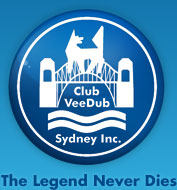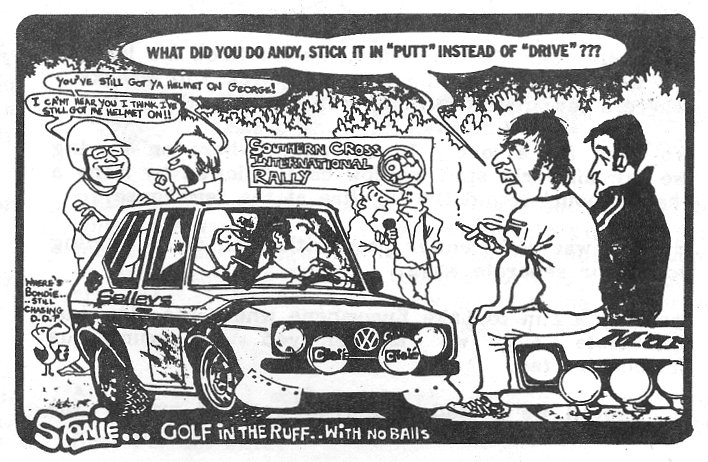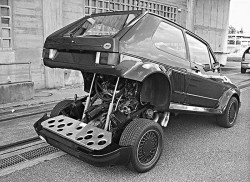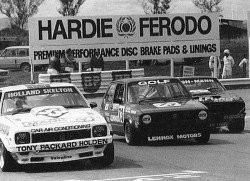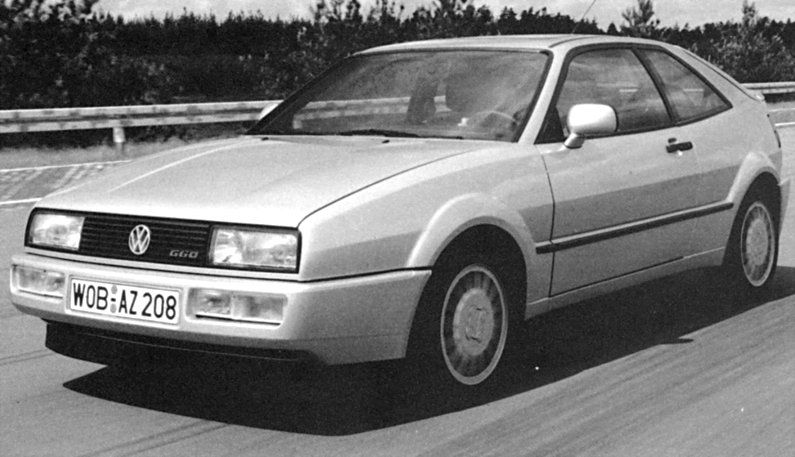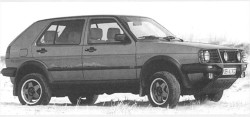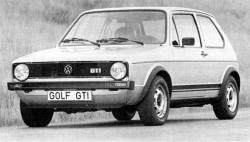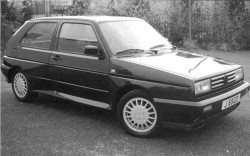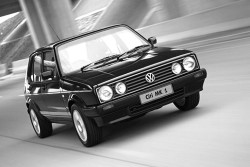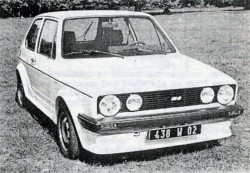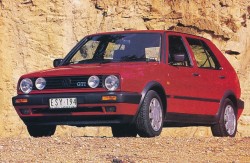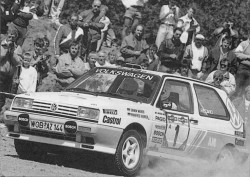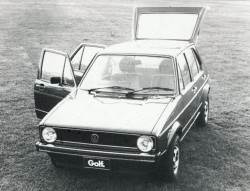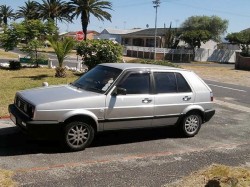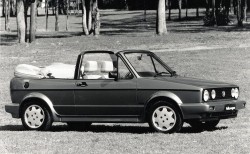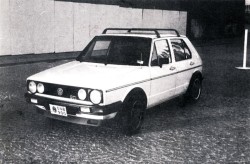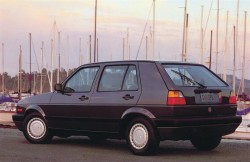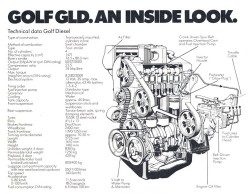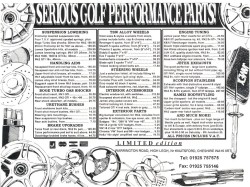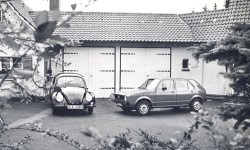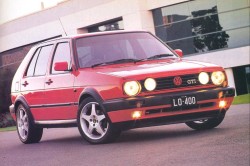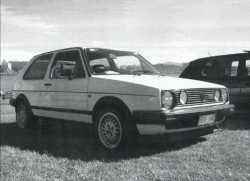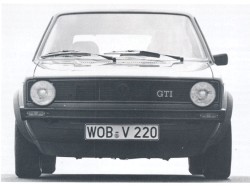Golf 1-2 and Scirocco
My Racing Golf GTI
Golf Bombshell!
Team Budget Racing
Corrado – Sporty but Comfortable
VW Golf Country
The Golf GTI Story
Test – Nothelle Rallye Golf
South African Performance
Golf 1 GTI 16S
Golf GTIs compared
British Group A Rallye Golf
The VW Golf Appears
South African 2-litre Golf
1993 Golf Cabrio Road Test
The City Car – Bumblebee
Success For the VW Golf
Diesel Dilemma
Golf 1 Bolt-ons
Golf Retro
Golf GTI in Australia
My Golf 2 GTI
The birth of the Golf GTI
My Racing Golf GTI
By Anthony Healey
December 1986
My Golf is a 1976 model GTI of a type that, on release in Europe, became an instant best seller. Ten years later, now in Golf 2 form, despite many imitations, the GTI is still king of the ‘Hot Hatchbacks’.
GTIs have been very successful in European road-racing and rallying, winning the Group 2 under-1600 Touring Car Championship in a number of seasons. Currently, the 1800-engined Mark 2 version has been competing with distinction in Group A rallying. The GTI driven by Kalle Grundel, for example, often finishes in the top ten placings against the Group B Audi quattros et al.
My particular example came to Australia in 1976, to be driven under the Lennox Motors banner by Chris Heyer from 1976-81. The 1588cc engine is basically blueprinted with a compression ratio of 11.3:1, uses the flat-faced head of the stock GTI with combustion chambers as bowls in the piston crowns, and is fitted with European Group 2 Bosch mechanical fuel injection, featuring four separate fuel injection trumpets. The net result is around 128 kW. A close-ratio 4-speed gearbox, coupled to a locking differential feeds the power to the road via three-piece BBS wheels and racing slicks in a most satisfying manner. Suspension is standard in layout but runs adjustable sway bars in polyurethane bushes, adjustable height springs and Bilstein competition dampers.
The car never realised its full potential unfortunately, being dogged by reliability and preparation problems. Its best performance was at Bathurst in 1979, in which it finished 7th in class and 28th outright. It was best known via television for catching fire in pit lane during a refuelling stop at Bathurst in 1980 (retiring shortly after), having qualified fastest in the under-1600cc class.
Golf Bombshell!
From ‘CAR’ Magazine
March 1987
Golf GTIs are fashionable cars in Europe, and the most fashionable are the ones painted black. There’s a GTI in Switzerland, owned by an industrialist in Montreaux, which is black but has gold striping and other changes, all subtle, to set it apart. Two air intakes on the flanks ahead of the rear wheels grab your attention first. Then you notice the tyres – enormous Pirelli P7s on ornate BBS wheels. Look inside and see that there are only two seats – two incongruous red leather armchairs, mounted on polished wood supports – that there is more wood for the dash and steering wheel, and extra dials. One, you notice, says ‘boost pressure’.
Look to the back of the cabin, and see that where once granny sat there is a platform, extending from the front seats to the rear door at window level. Underneath it, you think, must be a lot of hardware. Come away scratching your head and look for more clues; there, where the badge on the tailgate usually says ‘GTI’, is written S...B...A...R...R...O. Yes, this is another oddball creation from the master of the oddball motor car, Franco Sbarro.
This Golf is worthy of the Swiss engineering eccentric. Underneath the boxed-in rear section is a Porsche Turbo engine, all 3.3-litres and 330 horses of it. The ‘industrialist’, whose name Sbarro is keeping to himself, paid about £35,000 ($A77,500) for this ultimate Q-car. In layout it resembles Renault’s 5Turbo – with a blown powerplant mounted amidships and driving to the rear wheels – but there the similarities end, for the solutions that Sbarro have come up with for the one-off are, well, different: like a body which is raised on hydraulic struts.
The Porsche engine, transmission and rear suspension are mounted on a subframe, racing-car style. The body is fixed to this by four bolts and those hydraulic struts; it’s a system that Sbarro has used before (for his Pilcar) and which he has patented. With the body raised – it looks largely unaltered but in fact has been strengthened by a 60kg tubular frame welded inside – access to the mechanicals is unrestricted. Sbarro says the whole powerplant assembly can be removed in 15 minutes. The hydraulic struts have another job: they hold the body firmly down on the subframe, with a force of 7 tonnes.
At the front there are the GTI’s MacPherson struts, completely retuned to suit the 195/15 P7s. Bigger 225 section P7s are fitted at the back, on light alloy wheel carriers with coil-spring A-arms and lateral links; again, racing car style. Brakes are 320mm ventilated discs all round. The steering is unchanged, although with the altered weight distribution – 60/40 in favour of the rear – it helps to have both seats occupied and the front boot full of luggage to keep the nose down. Loaded like this, the weight distribution becomes about 50/50; ideal.
At present the Golf Turbo is running in but soon it will go to Germany where, on the autobahn at 6000 rpm in fifth gear, a true 260km/h is expected. At 1,100kg the VW is 180kg lighter than a Porsche Turbo, and it was this that encouraged Sbarro to go for a gearbox with taller ratios; in the end, the five-speed ZF DS25 box – used in the BMW M1 – was chosen. The priorities, after all, were supercar-style acceleration but with easy handling in city traffic. It’s because of this slight compromise that the car is not as quick as you’d expect off the mark, reaching 100km/h in a very good but not all-conquering 6 seconds.
Later on, however, when the turbocharger is fully on song and the tachometer needle is in the useful 3800-6000rpm band, the Golf gets up and goes, in true supercar fashion. Around town it impresses too, for the Golf is easy to drive slowly, being smooth and quiet for most of the time.
The Golf Turbo looks as though it goes around bends well and it does; flatly, securely and with those Pirellis hugging the tarmac. The steering is light and the controls easy, and on smooth, dry roads it feels relaxed and comfortable, the handling quite neutral at modest speeds. How it behaves at higher speeds – and in particular the quality of the steering on fast motorways – is something that we’ll have to wait to find out.
Changes to the car include a 100-litre fuel tank – it does about 19L/100km (15mpg) – under the reinforced front boot and those air intakes; Sbarro claims they provide more cooling air to the engine than in a Porsche Turbo. Inside there are those odd seats, assembled as one unit, and the boost pressure gauge, with oil temperature dial and quartz clock, mounted in the space normally taken by a radio; this Golf has a full-house hi-fi system low on the centre console.
More than 20 years ago an American became famous for driving a white VW Beetle from Place de la Concorde to L’Etoile in downtown Paris. Under the Beetle’s bonnet was a Chevrolet V8 engine. It started something, and the quest for bigger and better Q-cars, the lookalike tin boxes with the monster muscle has gone on ever since.
Now, however, with Franco Sbarro and a lot of other people’s money they are for the autobahn, not the town. And no doubt this is where the Swiss owner – who incidentally intends to use the Golf every day to get to work – will point his blown black bombshell. He will be very fashionable. And he will be very, very fast.
Team Budget Racing
By Anthony Healey
November 1987
Date: 23 August. Event: Australian Racing Drivers’ Club, Amaroo Park Main Circuit. This event clashed with the one weekend a month that I work at the Westpac Computer Centre. I had myself rostered on the 8:00pm to 8:00am shifts on both Saturday and Sunday. I don’t have a tow-car for the Golf (the ex-Lennox Motors Bathurst 1000 race car) and its trailer, so I hire a Rent-A-Ute. It works out at about $45 a day all-up, which isn’t too bad as a car large enough to do the job would cost about $400 a year just to register, and I wouldn’t like to drive something like that daily.
I picked up the ute about 6:00pm Saturday night and took it home, intending to take the whole rig to work for the night and leave first thing after knocking off for the night. At home I noticed that the ute did not have a towing tongue, and of course the one off my Passat did not fit. Terrific. I drove to work, stopping at the garage where I hired the ute to see if they had its tongue tying about; no luck.
At work, I checked colleagues’ cars in the car park, hoping to find a matching piece. One was the right shape, but the two mounting holes were spaced differently. My manager was just leaving when he had the inspiration to call the building engineer on the night shift. Yes they did have a workshop, and might be able to help. After the workload slowed down about 2:00am, I bolted down to the car park, removed the entire tow bar from the ute and met the engineer in the workshop. The biggest bolt and tap available was around 9/16”, so a hole was duly added with a minimum of fuss and I was away with my borrowed tow tongue. Of course the new bolt was a problem. I think it was a BSP gas thread, which was not easily available on a Sunday morning. A visit to a fitter friend on the way home saw a suitable bolt fitted after a lot of rummaging, and I finally rocked up to Amaroo Park about 11:00am.
The car was scrutineered on the trailer and I was ready for action. Hopes were high as the previous event by the ARDC on this, their home circuit, five weeks earlier had been a monumental disaster in organisation. A field of 130 entries where 70 is normal and manageable led to chaos and very little track time. Surprisingly on that occasion I had picked up a fastest in class trophy (faster than the winner of the next-higher class as well!), as the car and I were in good form. It had also rained a little, just to help add insult to the injury.
Today’s event was looking good, the weather perfect, the field classy and orderly. Something had to go wrong…
Something in reflecting sunnies, Akubra, King Gees and propelling a large gut loomed up to bring me back to reality. It was unhappy with my carefully chosen, out of the way (so I thought) parking spot and proceeded to loudly overbear me, giving me an excellent impression of one of those southern Sheriffs that always appear in Smokey and the Bandit movies. Even the passers-by were astounded, as I was in the process of moving the ute and trailer when the oaf arrived. In my haste to move the rig I neglected to secure the bolts that told the tilting trailer deck down, and they dropped out and disappeared in the car park gravel.
The next problem was the Golf itself. It had run nicely the day before, had driven on and off the trailer ok, but now while warming it up in the pits it started to idle roughly. Hmm, maybe it needed a good run to clear the cobwebs. It certainly seemed OK under the bonnet.
On the track something was definitely amiss (no pun intended). It wouldn’t rev over 5000rpm and didn’t feel as if it could pull your granny off the dunny.
Back in the pits the first things checked were the electrics. I’d changed the plug leads since the last event, as one of them had perished or heat-damaged insulation. No problem, the leads were tight and the plugs clean, the spark was strong and the dissy rotor where it should be. The ignition is pointless electronic, but once before the rotor had spun freely on its shaft after its locating setscrew fell out! To be on the safe side, I put the old leads back on, but this didn’t help.
Fuel was the next suspect. The injection distributor seemed to be passing the avgas but maybe not enough. Pulling the filter out revealed an amount of fine gritty particles on the tank side. Oh oh. Removing an injector line and an injector revealed more…
I had run out of fuel two events earlier (there’s no gauge in the safety fuel cell), and maybe some sediment had been drawn into the system. Well there was no shortage of willing helpers keen to learn about the workings of a Bosch mechanical injection system. Of course it’s like no road car system and I didn’t get a workshop manual with it. Removing every line, plug and valve we could find, blowing them out and washing in clean fuel, the whole thing went back together. Cranking it didn’t get much result and no fuel, until a line was loosened, releasing a hiss of air and a bubble of fuel. Prime it! Bleed the air trapped in the system! Trial and error and more spanner work and it was running. Great! Line up a challenger, join the queue and go for a drive.
On the track the little GTI growled nicely on the warm-up lap, the gauges were normal and the slicks were beginning to grip.
First time up the hill on full noise and over the top of Bitupave it went hiccup and back to what might have been three cylinders - #@&K !! More blowing and bleeding (huffing and puffing?) and still we couldn’t get rid of the rough idle. Retirement. Back home to bed for a few hours before going to work for another overnight shift.
Date: 10 October. Event: University Car Club, Oran Park. The fuel system had been cleaned and the filter replaced; an Audi 5E part courtesy of Muller and Muller VW came closest, and fitted except that one of its threads was different from the original. A trip to Enzed at Smithfield (they’re a good mob, by the way, ceap and cheerful) had an adapter made up. On putting it back together I found that the main braided line from the filter to the fuel distributor had a fair leak that was not there before. Oh well, back to Enzed. They were still cheerful, but high-pressure braided stainless steel is NOT cheap. Professional racers I can understand, but how the hot-rodders can afford metres of the stuff its pose value is beyond me.
I also decided to repaint the front spoiler, having finally matched the colour. The trusty Little Beaver put the first coat on nicely. I waited the required 15 minutes for it to go off. Lining up the gun for the final coat, the air hose popped off the back of it and fell on the concrete, blowing all the dust and stray grass clippings etc onto the still tacky first coat – was this an omen, I wondered?
Race day dawned clear and sunny. I’d had a good night sleep, and felt cautiously optimistic. To cut a long story short, the car started well, drove onto the trailer well, was scrutineered well, the sun shone and the bloody thing stayed in the pits ALL DAY after the fuel problems returned! My first DNS (Did Not Start) result in seven or so years of assorted club motor sport. The next move is to put the spare fuel pump in and see if the bad delivery is due to low system pressure, as I thought the existing unit didn’t sound the way it normally buzzes electrically. If that doesn’t work, I guess I’ll have to take it to Roy Goodman or Barry Jones for a going over.
Corrado – Sporty but Comfortable
Translated by Rod Young
December 1988
The Corrado is a genuine sports car, says VW. And in Wolfsburg they’re proud of their brainchild. The Corrado is not meant to be a successor to the Scirocco, but a model in its own right with no less than 118kW under the bonnet and a top speed of 225km/h. Zero to 100km/h in only 8.3 seconds. That’s entering into Porsche 944 territory, and the Corrado even just surpasses the Porsche in terms of pure performance.
But it's not just top speed, says VW, that makes a sports car. What then? Perhaps the interior is cramped and smells of leather and the pedals are heavy to operate? None of that is to be found in the Corrado. With a 4.04-metre overall length and a wheelbase of 2.47 m, there is an amazing amount of room inside You sit comfortably in very well shaped and firmly padded seats and can easily find the ideal relationship to pedals and wheel. Seat height-adjustment is standard, and a tilting steering column is available as an extra. Also standard are power-assisted steering and ABS brakes.
The instrument panel is slightly angled towards the driver and all switchgear is conveniently positioned. Two gauges on the centre console give information about oil temperature and pressure. Directly in the driver s field of vision are three large round dials for speedometer, tacho and clock. The thickly padded steering wheel is nice and grippy and the horn button is right in the middle. Height-adjustable seat belts, correct belt geometry and head restraints, which are high enough for even the most corpulent of people, score good points for the Corrado s interior.
Behind the front seats, there's no lack of room, like we have become accustomed with other sports cars. In the back of the Corrado you can sit without tying your legs in a knot. This is a car that is superbly suited to the young family with a child.
The boot also offers a surprising amount of room, with 300 litres of volume. The compartment is well finished, flat and is easily extended by folding forward the split rear seat. Even quite bulky objects can be stowed here. The back seat catches work easily by means of retractable pins.
So far, the Corrado is a quite normal, sensibly thought-out and functional coupe. But what makes it a sports car? The motor, of course.
As if to order, VW s new chief of technology and successor to Ernst Fiala, Professor Ulrich Seiffert, appeared on the scene in the middle of our test-drives around Wolfsburg. Seiffert, accompanied by a team of engineers on last-minute tuning efforts, asked, “What do you think of the engine? Isn't it a beauty? Powerful, quiet, wonderful. This will be my daily driver." In actual fact, the Corrado motor makes for a whole lot of fun. In spite of its diminutive 1.8-litre capacity, this motor pours out so much power that you'd swear it came from at least 2.3 litres. By 2300rpm, 200 Nm of torque is already available, reaching the maximum of 225 Nm at 4000/min. With these sorts of figures, the Corrado isn't in the least a fussed power plant and comes on strong from low revs. That makes driving relaxed and spares a lot of gearstick rowing.
How it's done: like the Polo G40, built only in small numbers, the Corrado gets its extra power from a so-called G-charger. This is a sophisticated box of tricks which pumps extra air into the cylinders in the same way as a turbocharger. Unlike a turbo, the G-charger, which in the Corrado is a G60, isn't powered by exhaust gases, but by a crankshaft-driven belt. This has the advantage that the G-charger starts delivering boost at low revs.
The functioning of the G-charger is extraordinarily difficult to explain. Imagine a spiral that looks like a capital G (hence the name), which wobbles in an eccentric orbit inside a round housing. All the while, the spiral is pumping extra air to the cylinders. Somewhat less satisfactory for combustion is the heating effect of the compression of the air in the G-charger, so it is cooled by 55 degrees in an intercooler. The result is 118 kW. That’s enough to propel the Corrado at a very respectable rate, although subjectively you don't get this impression at first. The engine is extremely cultivated and even at very high speeds you can easily hold a conversation or listen to the radio.
And that's supposed to be sports car? Not loud? Not cramped? There's more to come yet.
Helped also by its purposefully-styled sheet metal (Cd 0.32), this sports car is also very economical, as the figures of 11.8L/100 km (town), 6.0L/100 km (90 km/h) and 7.5L/100 km (120 km/h) testify. The motor, which uses a fully electronically controlled ignition and injection system (Digifant II) requires Super fuel, but can also be driven for a short while on Standard Lead-free, of course, since the Corrado has a 3-way controlled catalytic converter.
And how does the Corrado drive? As smoothly as a limousine and comfortably sprung. Even at high speeds the car remains quiet. At a speed of 120 km/h a rear spoiler automatically extends and is retracted at 40 km/h. The car is easily pointed by precise servo-assisted steering. The fact that the Corrado lifts an inside wheel in enthusiastically driven corners is negative purely for aesthetics and has no effect on safety.
All in all, a cultivated sports car. It looks particularly sporty, and the fact that it isn't cramped, loud and hard-riding like earlier sports cars can hardly be levelled against it as criticism. But the driving feel is what really makes the Corrado the capable sports car that it is.
The VW Corrado has, in fact, already withstood its first real test. A higher-powered 162 kW version has just broken six high-speed durability records for turbocharged petrol cars in the 1500-2000 cc class. The records broken were for 500 km, 500 miles, 1,000 km and 1,000 miles. Average speeds of 257km/h and 262.8 km/h were attained, with a top speed of 270km/h.
VW Golf Country
By Rod Young
September 1990
Here comes a Golf for those who find the basic Syncro too commonplace and inconspicuous. It's called the Country, but it feels equally at home in Kensington. The Country is not the prettiest of hatchbacks, but it does look different from the rest of the range. The first thing you notice is the raised body, which sits atop the wheels like it's been jacked up. Eye-catcher number two is a massive bull bar made of fat, black iron pipes. Another characteristic feature is the spare wheel, which sits on a swing-away support mounted to the rear bumper. This device guarantees full marks in the Young Farmers Club car park, but it is awkward anywhere else because the wheel seriously impedes access to the tailgate and thus to the boot. But since the spare lives outside the car, the luggage area is slightly bigger than before.
The Golf Country started its career in November 1988. Chief designer Herbert Schafer was at that time preparing it for the Geneva Show where it debuted as a concept vehicle named ‘Montana’. Although rebadged, the production version still carries silly graphics on the doors that suggest that this neo-off-roader is fit to tackle the Rockies.
The Golf Country is prepared in Graz where Steyr-Daimler-Puch (SDP) has invested £4 million in new conversion facilities. SDP was also responsible for most of the development work. The Austrians are already rubbing their hands in glee because Europe has apparently fallen in love with the stork-legged Golf of which 4000 units will be built each year.
The conversion procedure is quite complex. When the off-the-peg Syncros arrive in Graz, SDP fits 120 mm tubular spacers which act as the meat in a sandwich consisting of body and suspension. Longer spring struts with a special off-road setting increase the ground clearance by 60 mm; in total, the ride height goes up by a very noticeable 180 mm. Steyr is also responsible for fitting the other add-ons. As soon as the body-colour alloy wheels are bolted on again, the cars are shipped to their final destinations.
Inside, there is very little Country but a lot of plain-Jane Golf. The only extras you get on top of the sombre CL pack are better-contoured seats, a sports steering wheel and suspiciously light power steering. While the tuning industry is offering a host of additional tack-on items, Volkswagen is working on a down-spec Golf Country for the peasants that will feature washable plastic seat covers and a solid forest-green paint job. Most options available for the low-flying Syncro are also available for the Country; just about the only key ingredient you can't have is an automatic.
Like the Syncro, the Golf Country is powered by a 73 kW version of the faithful 1.8-litre four. But because the 1245 kg Country is a substantial 160 kg heavier, and because its drag coefficient is significantly increased, the performance figures are definitely less impressive.
What you get for the extra money is a generous helping of show appeal, as well as more comprehensive standard equipment. You will also benefit from a more commanding driving position and from more ground clearance, which does improve the car's all-terrain ability. But from A to B, this Golf drives and feels pretty much like its lower sister. There is a little more body roll and a little less ride comfort, but I found no serious drawbacks. In the final analysis, however, the Golf Country is neither fish nor fowl. Off-road, it can't compete with the serious mud-diggers; on-road, it's among the slowest and least economical Golfs you can buy. It does turn heads, but the novelty value alone doesn't make it interesting enough.
The Golf GTI Story
By Phill Lander
March 1991
The Sport-Golf began as an official Volkswagen design project in May 1975, code named EA195, and was to be a limited production run of 5,000 cars so that it could be raced as a Group 1 Production Touring .Car. The first prototype was powered by the twin-choke carburettor engine from the Audi 80GT. The Volkswagen engineers didn't think that 100 bhp was enough, so they started developing the engine to suit the Bosch K-Jetronic fuel injection. This boosted the engine output to 110 bhp, which the engineers thought was acceptable for a sports car.
The first prototype shown to the public was at the Frankfurt motor show in September 1975, where it was labelled as the GTI - for Grand Touring Injection (and note the CAPITAL I).
After extensive testing the GTI was made available for sale to the public in June the following year (1976). So successful was the GTI that the original 5,000 units sold quickly, and a decision was made to put the car into full production instead of the limited edition special as planned.
The GTI was not sold in Australia. The Golf was introduced to Australia in March 1976, in locally assembled, 1.6-litre ‘LS’ spec only. German models such as the L, GL and GTI, were not imported. In 1977 local assembly ceased, and the Golf became fully imported in uprated 1.6-litre GLS spec only. The diesel GLD version was introduced in 1978, but the GTI was not sold here. Petrol Golfs were discontinued in 1979, and the diesel GLS Golf continued alone until all VW passenger car sales ceased in 1982 – but the last ones sold had actually been imported in 1980!
For Europe, in 1979 the GTI became available in right-hand drive for the first time, and began to sell well in Great Britain. 1980 saw the introduction of the five-speed gearbox with its close ratio 3rd, 4th and 5th. The first major engine improvement was made in 1982 when the bore was increased to 81mm and the stroke to 86.4mm, giving an increase in capacity from 1588cc to 1781cc. This combined with a new head and a raised compression ratio of 10:1 gave the GTI an increase of 11 Nm of torque and another 2 bhp. The 148 Nm of torque was now developed at 3,500 rpm instead of the previous 5,000 rpm, which made it much more driveable.
The new larger Golf 2 was released in August 1983 and although the drag coefficient reduced from 0.40 to 0.34, the extra 110 kg of bodyweight took the edge off its performance. From the beginning the 1800 motor was designed to be equipped with the 16 valve twin-cam head, which became available in the Golf from November 1985. This gave an increase in power to 139 bhp at 6100 rpm and increased the top speed to 208 km/h. Along with the higher output engine the GTI 16V has been lowered 10mm and has larger ventilated discs with larger pistons being cooled by air ducted from slots in the front spoiler. Because of the change in position of the distributor, the aerial was moved to the rear of the roof to eliminate radio interference.
Since 1988 the design engineers have been busy developing 3 more variations of the GTI. First came the Golf GTI Rallye with the 160hp G60 supercharged 8-valve engine from the Corrado, combined with the Syncro four-wheel drive system. The Golf Rallye is easily identified by the larger than usual guard flares that are required for clearance of the 6x15 alloy wheels.
Next of the hot hatches is the Golf GTI G60 which is basically the same as the GTI 16V but fitted with the 8 valve G60 160 bhp motor.
By far the quickest Golf ever put into production is the Golf G60 Limited. This Golf uses the G60 supercharged engine with a 16 valve head and produces 210 bhp in standard form, driving all four wheels through a Syncro coupling. VW Motorsport will be rallying this limited edition special in the future and hope to get over 300 bhp from the 1800cc engine.
1992 should see the release of the third generation Golf and some more new engines including the narrow-angle V6, which has been planned for some time. I only hope that Australia gets to see some of the quick Golfs instead of the old 8 valve models which we ended up with.
Test – Nothelle Rallye Golf
By Rod Young
April 1991
More power for Wolfsburg’s 4-wheel drive road burner. 0-100 in 7.5 seconds and 230 km/h for 6900 DM.
When the Rallye Golf was first released to the public one year ago with a limited production run of 5000, the expectations of many people, and GTI fans especially, were very high. With 120 G-Lader kilowatts, four-wheel drive and the right power look, this had to be the ultimate Golf. But the up-market luxury equipment level and conglomeration of technical features pushed up the car's weight to such a degree that the Rallye Golf was definitely held back where performance was concerned.
At the time we measured acceleration from 0 to 100 in 9.2 seconds and a top speed of 211 km/h. Too little for a car of this name, and sales didn't exactly take off either. But the experienced touch of the tuner can work wonders and give the Rallye Golf 157 kW.
Rolf Nothelle from Mulheim on the Ruhr offers this lift in power of 37 kW for the price of 6890 Marks, and promises true sports-car performance. Changes to the powerplant are moderate. The fairly tame standard camshaft makes way for a sports model with 280°, the cylinder head is optimised for flow and the boost developed by the G60 supercharger is raised to 0.75 bar. The key to the success of the quest for power with the G60 motors lies in tailoring the ignition and injection electronic maps. These have to be patiently and accurately adapted to the changed conditions if fuel consumption and smooth running are to be maintained along with the increase in power.
For this reason, Rolf Nothelle gives his product a completely re-mapped control unit. Otherwise the four-cylinder fuel-injected motor remains untouched; even the exhaust system remains standard.
This last item has a restraining effect on the noise output of the modified Golf. A muffled, sonorous burble, completely at stock levels, gives the car an effect that fits well with the up-market luxury impression expected of the Rallye Golf. The idle is faultless, no difference here either from the standard product.
On the road, the 157 kW motor makes its presence felt in a way which is spontaneous and enormously powerful. In contrast to the standard product, the tuned version is impressive in the way it gives an immediate push in the back and excellent performance. Acceleration from 0 to 100 km/h is achieved in 7.5 seconds, the advantages in traction of four-wheel drive undoubtedly coming into play. There are no screeching, spinning wheels, and no worrying steering effects. And it reaches 231 km/h in fifth gear.
Astounding, really, given the boxed-out mudguards and wide tyres.
But not only the performance in the top end is impressive; the strong punch in the mid range gives a lot of driving pleasure. When accelerated in fifth gear from 60 to 100 km/h, the Nothelle Golf takes 12.0 seconds, compared with 15.0 seconds in the stock car. Three seconds can be a small eternity.
The fact shouldn't be hidden that the fun of driving the Nothelle Golf has its down side in fuel consumption. Just on 14 litres of expensive Super Plus flow through the four injectors every 100 kilometres. But don't forget that the standard vehicle also needs 13 litres. Unfortunately, the tuning measures disallow the tax concession for lead-free fuel, as the Rallye Golf only fulfils the Euro-standard after the modifications.
The Rallye Golf comes from the factory with widely flared wheel arches; this is necessary for homologation for the racing version. Even the standard 205 tyres seem lost in there, so Nothelle gives his vehicles wider 7J x 16 wheels as well as a change in track; 30 mm at the front and 40 mm at the rear. In addition to these come springs which have been specially tuned to the standard dampers. These springs also achieve a slight lowering of the body. With the above equipment installed, the Nothelle Golf has just that amount of extra stiffness that we missed in the standard car. The driving behaviour is measurably more stable, without comfort being affected too much. The tendency towards understeer in fast corners is noticeable; abrupt load changes get the rear drifting outwards, which can easily be corrected with a bit of opposite lock. This is a purpose-built suspension, which fits well the extra performance and the car as a whole.
The Nothelle Rallye Golf is a bit of a secret tip. If you bought a second-hand Rallye with a few thousand kilometres on the clock and brought it to Mulheim for the power cure, you would have - for the price of a new GTI G60 - something quite special. A luxurious Golf with an excellent, high-powered motor and the appropriate suspension, which always delivers any amount of driving pleasure without getting on your nerves with typical tuning disadvantages. And, who knows, maybe Rallye Golfs will be much sought-after collectors pieces in a few years time.
South African Performance
By Phill Lander
May 1991
South Africa is a performance car enthusiast’s paradise. The local representatives of manufacturers like BMW and Ford have, over the years, come up with their own home-grown derivatives of European models which would leave enthusiasts here green with envy. Back in the mid-1980s, when the fastest BMWs in Europe in their respective ranges were the 323i and 745i, the former with 150 bhp and the latter a turbocharged 3.2 litre 252 bhp autobahn stormer, BMW of South Africa were somewhat more adventurous and installed the larger 3.2 litre straight-six in the 3 Series body to produce the 197 bhp 333i. While BMW AG had yet to spawn the 24-valve bhp M5, BMW SA took this M1-derived power unit for their version of the 745i flagship.
Down the road at Ford, V6 Essex-engined Cortinas and Granadas were being supplemented by locally developed V8-powered versions of these cars, and the ultimate fast Ford was made in 1985/6 as the Sierra XR8 homologation special. This five-door Sierra with its RS alloys and XR4i tailgate biplane spoiler packed a five-litre SVO V8 engine of 205 bhp under its rep-car bonnet. It also had seriously uprated suspension and huge ventilated racing discs with four-pot callipers all round.
If this is what other manufacturers were doing at the time, Volkswagen of South Africa was just pulling itself out of the doldrums.
A wholly owned subsidiary of Volkswagen AG, VWSA was the market leader in 1979/80 following the local launch of the Golf the year before. The company's market share was around 20 per cent. Unfortunately, local quality control problems saw this share evaporate by half in the ensuing four years.
In the face of a declining market in the country as a whole, VWSA set about rebuilding its image and from 1985 onwards it has been the only local car maker to increase market share every year.
When the first Golfs rolled off the production lines in 1978, knowledge of the GTI version in Europe prompted development of a local performance derivative. This turned out to be a five-door car with similar trim and instrumentation to the GTI but powered by a 86 bhp carburettor version of the 1.6-litre engine. It was dubbed the Golf GTS.
The GTS was a resounding success, and this prompted VWSA to introduce the GTI in 1983. As this coincided with the 1983 model year in Europe, which introduced the 1800cc engine, the original GTI 1.6 litre was never sold in South Africa. Having said that, two years previously, the company did import 100 Golf GTI Cabriolets and 100 Scirocco GLIs, and these cars are much sought after on the used car market today.
The VWSA GTI series 1’s suspension was adapted for local road conditions, which vary from good quality tarmac to dirt roads. The cars ended up with firmer suspension and more ground clearance to cope. The shock absorbers were locally sourced, as the German ones were felt to be too firm for local conditions. Standard footwear was 175/70 HR13 steel-belted radials on locally made alloy wheels.
The South African GTI was - and still is - badged GTI. From the word go, the cars have had a higher specification than their European counterparts, with a four-headlamp grille and alloy wheels appearing on all versions, including the early GTI cars. All GTIs have also had five-door bodyshells, and the latest series 2 cars have still not adopted the centrally positioned rear VW logo for either Golf or Jetta. As in Europe, a leather trim option is available but this is full-leather rather than just the seats and is standard on top of the range GTI 16V Executive, along with power steering, air conditioning, central locking, Pioneer stereo, electric windows and mirrors, alloy wheels and a four-spoke leather-bound Italvolanti sports wheel as standard.
In 1984, the Jetta GLI was introduced to the market and, as in Europe, this model shared the GTI's mechanical specification. It differed from European GLIs by having exactly the same interior as the GTI. With motor sport being very popular in South Africa, in no time at all the GTI was well established in production saloon racing and rallying, winning a number Championships.
VWSA was catching up fast with new European models, and bolstered by sales successes, it introduced the series 2 Golf at the end of 1984, soon after the car’s European debut. The GTI version followed in early 1985, and this came with 6x14 locally made alloy wheels and 185/60 HR 14 tyres.
The Golf GTS was reincarnated in series 2 form, again using a carburettor version of the GTI motor. This gave 85 bhp instead of the 112 bhp produced by the fuel-injected version, and the interior trim of the GTS was identical to the GTI’s apart from the deletion of the MFA computer. Externally, though, you could tell the GTS at a glance as it had 13in. diameter steel wheels. Suspension of the VWSA series 2 cars once again used locally made springs and dampers. When the 16-valve version was introduced in August 1986, German suspension settings clearance were once again judged too harsh and too low for local conditions, so the same suspension as the eight-valve cars is used.
The exhaust system on VWSA series 1 cars is the same as the Wolfsburg-built models, but the series 2 use a reverse-flow stainless steel muffler design which gives a slightly higher back pressure. Despite this, power outputs are unchanged. The exhaust pipes are also made of stainless steel as the German ones corroded through in about 18 months under South African conditions. The tailpipes of this stainless steel system are also larger, but exhaust manifolds are the same as the German ones although there is as yet no requirement for catalytic converters.
Other local modifications include a dust sealing package, right-hand drive wiper pattern locally tooled-up for since 1978, and, from 1988, all series 2 Golfs have come with a factory-fitted security alarm which has an auto-arming immobiliser. This is activated by a coded transmission from a key-ring transmitter tied into the central locking system.
The sports seats found in VWSA cars are not the same as the German ones, even though they appear outwardly similar. All GTIs have leather gearshift gaiters.
The Jetta equivalents are badged as CLIs. There are three models - the CLI, CLI Executive and the CLI 16V Executive. The CLI has the eight-valve 112 bhp engine and central locking, leather steering wheel, sports seats, electric mirrors, alloy wheels and Pioneer stereo as standard; the CLI Executive specification adds power steering, electric windows and air conditioning and the 16V has all of these plus the trim from the Golf GTI.
Digifant electronic injection does not feature on VWSA cars. Current eight-valve models still use the Bosch K-Jetronic system and, of course, the 16Vs have KE-Jetronic.
An interesting hybrid car still in production is the Citi Golf Sport. This popular entry-level vehicle is the spiritual successor to the original series 1 GTI and has a carburetted 1781 cc engine giving 95 bhp. This is a five-door with locally re-engineered bumpers and grille. But, by this autumn, VWSA will have put into production the definitive series I GTI. They plan to relaunch the fuel-injected 1.8-litre car as the Citi Golf CTI. It will have Citi graphics, 6x14 alloy wheels with 185/60 HR14 tyres but, rather than being just a latter-day copy of the original, the engineers have solved all the niggling problems like poor brakes that plagued the original.
Another interesting car to be launched later this year is a two-litre Golf 16V GTI with more than 170 bhp. As we noted at the start, South Africa is a performance car enthusiast’s paradise.
Golf 1 GTI 16S
By Phill Lander
June 1991
With increased competition from the Ford Escort XR3 and the Renault 5 Gordini, VW in France was concerned that the GTI would lose its place as market leader (50% of Golf sales in France were GTIs).
The solution came in the form of the Okrasa 16-valve cylinder head, which Oettinger had been developing as an aftermarket conversion kit for the Golf. Oettinger had been tuning VWs for more than 30 years, and their twin cam cross flow head appeared in the late 1970s as the growing GTI following brought with it a demand for ways of improving the standard product. Oettinger's engine retained the cogged-belt drive to one camshaft, with the second camshaft gear-driven from the first. Experience with this unit was to play an important part in the development of VW's own 16-valve head later.
The Oettinger head was designed to bolt straight on to the 1.6-litre engine. Even so, long-term reliability was looked at properly and new forged pistons were fitted to suit the new combustion chamber shape and increase reliability. Combustion ratio was now 10.5:1. The crankshaft and connecting rods were balanced and the oil pump uprated to cope with higher lubrication demands. A light alloy sump with intricate baffling to keep the oil from surging in high-g cornering was fitted. With an uprated K-Jetronic fuel system, the power output rose from 82 to 102 kW at 6,500 rpm and torque went up from the stock 137 Nm at 5,000 rpm to 157 Nm at 5,500 rpm.
Oettinger pronounced the engine good for 8,000 rpm, while not advocating exceeding 7,000 rpm too often, and fitted it with a lower final drive (4.17:1) to allow for it to pull 7,000 rpm in top. At those revs, the car would do a genuine 195 km/h on 185/60HR14 tyres. They chose Uniroyal rubber and 6J x 14 ATS alloy wheels. The uprating job was completed by adding a lower wishbone strut brace to the front suspension, and specifying fast road brake pads.
Cosmetically, these cars were altered by the addition of a BBS body kit, the Hella four-headlamp grille and 16S badges. The S is for ‘soupapes’, French for valves.
Up to this point, any customer could buy an Oettinger conversion, but with the idea of selling complete cars through VW dealers in France, the car had to undergo extensive tests at the factory. It passed these tests and gained the benefit of the full VW dealer warranty. The factory in Wolfsburg was particularly keen on the car because, after 400 were made, they could homologate the 16-valve engine for Group 4 competition. The arrangement was that VW would supply complete Golf GTIs to Oettinger, who would modify the engines and return the unused parts - cylinder heads, pistons etc.
With a 0-100 km/h time of 7.4 seconds, the 16S was the full measure of the opposition, even the Renault 5 turbo of its day and indeed the later Fiat Strada Abarth 2-litre, but it cost 50% more than a standard 1600cc GTI.
Golf GTIs Compared
By Phil Matthews
July 1991
From the situation in 1976 when there was only one model of Golf GTI, the 1600cc 8-valve 110 bhp ‘series one’ (which was never sold in Australia), Volkswagen has developed the original hot hatch to the point now where there are no less than five different factory versions. Some are familiar, others less so, so we present a breakdown of the five current Golf 2 variations of GTI - from mild to WILD!
1A. 8V – Australian spec
1781cc, 10.0:1 compression, 77 kW @ 5400rpm, 155 Nm torque @ 3800rpm. Max speed 182 km/h, 0-80 km/h in 7.2 sec.
This basic GTI, with five doors, is the model currently sold in Australia, having debuted here in 1990. It is a ‘low-spec’ catalyser engine designed to run on the unleaded fuel sold in Australia, and was originally specified for the Japanese export market. It is the only GTI that can legally be sold in Australia.
1B. 8V - Europe
1781cc, 10.0:1 compression, 83 kW @ 5800rpm, 157 Nm torque @ 3100rpm. Max speed 192 km/h, 0-80 km/h in 6.5 sec.
This is the European GTI version of the Golf 2, debuting in Europe in June 1984. It is designed for higher-octane leaded fuel, currently still available in Europe, so the power output (and performance) is higher. Unfortunately it, and the hotter GTIs below, don’t meet Australian design rules. Syncro 4WD and ABS are options in Europe. Volkswagen has sold more than one million 8-valve GTIs since 1976.
2. 16V
1781cc, 10.0:1 compression, 104 kW @ 6100 rpm, 168 Nm torque @ 4600 rpm. Max speed 207 km/h, 0-80 km/h in 6.0 sec.
Not sold in Australia. Appearing in February 1986, the RHD 16V GTI uses the same engine used earlier by the 16V Scirocco. The 16V head, made of warm hardened cast aluminium, has vertical sodium-filled valves, and paired inlet valves inclined at 25°. Hydraulic tappets reduce maintenance, the camshafts are roller chain driven, and the larger oil pump from the diesel engine is fitted. Externally difficult to tell from the 8V, it has standard alloy wheels, electric windows, central locking and small 16V badges.
3. G60(8V)
1781cc, 8.0:1 compression, 119 kW @ 5800rpm, 225 Nm torque @ 3800rpm. Max speed 217 km/h, 0-80 km/h in 5.7 sec.
Not sold in Australia. Launched in April 1990, the GTI G60 uses the supercharged 8-valve engine already seen in the Corrado and Passat. Engine is a normal 8V engine with G-Lader, with few changes except reduced compression. Available in LHD only. Syncro 4WB and ABS standard. MQ cable gearbox from Passat, with Passat gearing, is also fitted. Few visible differences from normal 8V GTI except lower suspension, Syncro wheel arches and small red G60 badges.
4. G60 Rallye (8V)
1781cc, 8.0:1 compression, 119 kW @ 5800rpm, 225Nm torque @ 3800rpm. Max speed 211 km/h, 0-80 km/h in 5.6 sec.
Not sold in Australia. Mechanically identical with GTI G60, the Rallye differs only in gearing, as the MQ gearbox uses VW Motorsport gears. Distinctive bodywork separates the Rallye from its brothers, with new squarer mudguards, sills, bumper and grille. Slightly larger 205/50 x 15 tyres on 6" Passat wheels. LHD only, Syncro and ABS are standard. Bodywork was designed primarily for clearance on rallies. Interior is identical with other GTI Golfs.
5. G60 Limited (16V)
1781cc, 8.8:1 compression, 157 kW @ 6500rpm, 252Nm torque @ 5000rpm. Max speed 230 km/h, 0-80 km/h in 5.0 sec.
Built by VW Motorsport in Hanover, this stock-looking Golf is fitted with a G60 supercharged 16-valve engine. Of Limited Edition, only 170 have so far been built and sold at $60,000 each. Standard equipment includes Syncro 4WD, ABS, VW Motorsport suspension, leather interior, electric mirrors and windows, central locking and steel sunroof. This 'sleeper’ is distinguished externally only by its BBS wheels, single headlight Golf GL type grille with blue surround, and blue VW Motorsport badges. Left-Hand-Drive only! Not sold in Australia (of course).
British Group A Rallye Golf
By Anderer Bleistift
December 1991
The Volkswagen Motorsport works Group A Rallye Golf G60 is currently making a serious challenge for honours in the British Open Rally Championship.
Of course, the Golf is not new to international rallying; indeed, it has collected its fair share of class wins, including a World Championship over the years. However, a change in the sport's regulations to a more production-based formula has inspired Volkswagen to lift its sights and aim for outright success.
Hence the introduction of the Rallye Golf G60 two years ago, as a car that would form the basis of a major international rally effort. The Rallye Golf has all the right ingredients to become a star on today's rally circus; most notably the viscous couping-based, Syncro permanent four-wheel drive system and G-Lader supercharged engine, also fitted to the 225 km/h Corrado G60.
While Volkswagen Motorsport in Hanover has concentrated on developing the Rallye Golf for the World Rally Championship, the UK Volkswagen Motorsport operation at Milton Keynes has put its weight behind making the car a winner in British events. The man in charge of the project is Nigel Walker, VW Promotion Manager. Development is led by former British rally champion Alistair Sutherland leading a team of engineers supported by one of Yorkshire’s largest VW dealers, Gilders. One of Britain's top rally drivers, Mark Lovell, sits behind the wheel.
“Volkswagen Motorsport gave us the go ahead in February 1990, and the car first appeared in April,” Sutherland explained. “Since then, we've been developing it more or less constantly. The factory Motorsport division did their best to help but were also busy developing their own cars.”
In January 1991, however, Hanover did supply a very important component - a new six-speed gearbox, as part of a whole transmission package. This included stronger viscous couplings, bigger driveshafts, stronger propshaft and new limited slip diffs front and rear. These bits cost almost as much as a standard Golf road car, but boost the Rallye Golf's competitiveness significantly.
You might wonder how a ‘production’ formula allows Golfs with six-speed gearboxes! The answer lies within the regulations. To go rallying, a manufacturer must build 5,000 examples of his chosen car, such as the Golf Rallye G60, in a year. There are then two divisions; Group N for basically showroom standard versions of those 5,000 models, and Group A, the frontline formula where many more changes are allowed. Not quite as many as in the old Group B formula however.
The interior can be stripped, the suspension heavily modified provided the basic pickup points remain the same, the bodyshell welded to increase strength, brakes can be beefed up, gear ratios altered and, most importantly, the engines can be souped up.
On top of this, the manufacturer is allowed to register – homolgate - special rally oriented parts such as, for example, a different steering rack, suspension components and, of course, a six-speed gearbox. A final rule is that cars run at specified minimum weights, which depend on their engine capacity.
This last rule is good for the Rallye Golf, as it creeps into a lower capacity class than its rivals and can thus run lighter. This is because the controlling body rates boosted cars at 1.7 times their actual size, so the Rallye Golf, with an actual capacity of 1763cc, is rated at 2997.1cc.
The G60 engine is potentially both the advantage and disadvantage of the car. David Power of Power Engineering has done the development of the engine. He explained: “A supercharged unit is quite unlike a turbocharged engine, where the power tends to come on suddenly after a slight delay. Rather, it’s immediate, lower down and across a broader rev range - all ideal characteristics of rallying.”
That's the advantage. The disadvantage is achieving the required level of power compared with a turbo engine, where you can sometimes dial in the required power. The standard Golf Rallye develops 119 kW, and Powers has now got that up to around 180-190 kW, but to be on the pace of the front runners another 40 kW is needed. He believes it can be done, but all extra power is more difficult and expensive to obtain.
The first step in finding more power was to make the supercharger spin faster to push more air into the engine. The standard G-Lader runs to a maximum of about 10,500rpm; in the current race engine it is spinning at 17,000 rpm by a combination of altered drive gearing and a higher engine rev limit. Boost pressure has gone up from 0.65 to 1.5 bar.
“To go much further we shall have to design our own electronic engine management program,” Power explained, “and that's a big step.” That will come later; first priority is to familiarise drivers with the six-speed gearbox.
Below the usual golf-ball, a stout alloy stick extends down to a linkage of astonishing complexity, which includes a spring-loaded reverse gear gate that makes the shift to reverse a definitely two handed affair. The gearbox itself is a non-syncromesh unit with straight-cut gears, called a ‘dog box’ in the business. With no syncromesh it's actually very quick and extremely positive in action under a knowing hand.
“The dog box is terrific,” driver Lovell enthuses. “In rally cars like the Golf you have to left foot brake to keep the car balanced when cornering, so your left foot isn't always available to use on the clutch.
“You can go up through this 'box without having to use the clutch; you just bang the gears in. Likewise, on the way down you just give the throttle a quick blip while braking and the gear slots straight in. The shift is very fast, too.”
Four wheel drive is essential to be competitive on loose surface rallies, but the Golf's system differs considerably from those of its rivals. Where they all use a centre diff to split and apportion drive front and rear, the VW uses a viscous coupling which progressively locks to engage rear drive as it detects a difference in speeds between front and rear axles; that is, wheelspin. It's a great system that is ideal on the road, but has needed slight modification for special stage rallying.
“Last year we found the car was rather nervous,” explained Lovell. “It would start to go through a corner in one way and then, as the extra drive took up, it would change its handling characteristics.”
The new transmission has a stronger coupling that locks more quickly. “It's a great improvement; the car feels better balanced and has a lot of grip - you can really feel the four-wheel drive working.”
Novell's verdict on the Rallye Golf was frank. “It has a lot of potential. The handling is good, the brakes are terrific and the gearbox will make a big difference, but it does need more horsepower. I'm convinced, though, that given reliability it's more than capable of winning a few rallies.”
Sutherland is confident the Volkswagen Motorsport team can make the breakthrough in 1992. “It's a tough job developing a competition car like this. Manufacturers spend millions on a new production model, then we have to make it go faster, stop better and go round corners quicker at a fraction of the cost,” he smiled.
The VW Golf Appears
By Phill Lander
April 1992
The VW Golf, which went on sale in Australia in March 1976, was one of a complete range of new models released over the preceding two years. The VW concern gambled its entire future then on the Golf and its brothers, the Polo, Passat and Scirocco.
The Golf’s arrival in Australia heralded the eventual demise of the Beetle, which had been built at Clayton in Melbourne since 1954. Nissan bought the plant from VW shortly before the Golf’s introduction, but production of it and the Beetle continued for another twelve months.
The Golf was one of the first of the new European cars to make maximum use of the squared-off hatchback body shapes. In Europe the Golf offered a choice of 1.1, 1.5 or 1.6-litre four-cylinder engines, but in Australia the car was offered initially just in the 1600 LS version, the engine being similar to that used in the Passat. Either three or five doors were available, and prices began at $4,300. The hot GTI version was not sold here.
Motoring writers in Australia fell over themselves with praise of the Golf when it appeared. The Golf was pitted up against established Japanese favourites like the Datsun 180B, Toyota Corona, Mazda Capella and Honda Civic, as well as local giant sellers like the Holden Gemini, Ford Escort and Chrysler Galant.
But even so, a typical surmise by one writer in 1976 was, “..with its advanced engine driving the front wheels, versatile body configuration and sparkling performance (it will top 160 km/h and offers 33 mpg running on standard fuel), its sales success seems likely only to be contained by government restrictions on local assembly growth rates.
“And if reports from correspondents in London and Washington tell a story, it is simply that with the Golf, VW Australia could be due for a return to the heady days of the early 1960s, when the Beetle was at the pinnacle of its local success.”
Unfortunately, this never occurred. After one year of unsatisfactory local production under Nissan control, VW completely stopped VW production in Australia and the Golf, together with the Passat, Audi Fox and Transporter ranges, became fully imported. The Golf was offered in improved GLS specification, but at a much higher price than previously, some $6,500. Even so, the new Golf had impressive credentials.
Like their earlier Aussie-built predecessors, the GLS Golfs had more leg room than the Torana, more head room than a Kingswood and more performance than a 250ci Falcon, yet in a package shorter than the Datsun 120Y. The German-built GLS was improved by a safety front bonnet, better crumple rate braces, additional under-body sealant and much improved trim. Standard fittings included intermittent wipers, chrome hubcaps, three speed fan, lockable fuel caps and improved carpeting and trim.
March 1978 saw the introduction of the Golf Diesel to Australia, following good public response in Europe and the USA. The 1.5-litre 38 kW diesel engine pushed the Golf to 80 km/h in only 11.5 sec, quicker than a Mercedes 300D, and a top speed of over 140 km/h, yet still achieve an average of 5.5 L/100 km in normal running. One perfectly standard model was driven from Sydney to Melbourne GPO by race driver Kevin Bartlett, at an incredible average of 3.6 L/100 km (77.8 mpg)!
The Diesel Golf was available only in GLD form, the equivalent of the luxury GLS petrol version. It went on sale in 1978 at $7,760, only $450 more than the petrol version by that stage.
The GLS petrol Golf was improved again for 1979, the last model year it was imported. Improvements included new energy absorbing bumper bars sheathed in flexible plastic, better emission controls with no air pump, a black screen behind the rear number plate and a restyled driver's mirror. New door hinges mountings were used, and new fully self-adjusting rear drum brakes were fitted. Inside, the seat belt locking device was fitted to the seat itself, while new velour and leatherette trims complimented a redesigned speaker housing on the dashboard.
Still fitted with the 1588cc engine, the ‘79 GLS carburettor Golf produced 53 kW, and the improved emission equipment allowed an 18.3 sec time for the standing 400 m, significantly better than before. However, prices had risen again, to nearly $9,000 for both the GLS petrol and GLD diesel versions, nearly twice the price of Australian and Japanese competitors.
The new-look Passat range (with four round headlights) also reached Australia in 1979, powered initially by the same 1588cc petrol engine, but by the end of the year were available only with the 1471cc diesel engine used in the Golf GLD. The Passat GLD sedan sold for $12,600, with the wagon at $13,200. These underrated cars, so popular in Europe, sold only in handfuls until they were withdrawn in 1982.
The petrol Golf also reached the end of the road at the start of 1980, leaving only the GLD version to soldier on in Australia. Several petrol strikes at the time kept the diesel Golf as a viable choice for Australian motorists, albeit a damn expensive one. Finally LNC decided to stop importing Volkswagen cars, and Golf sales ended in 1982. While the Transporter continued on as the only Australian-sold VW until LNC lost the VW franchise in 1987, they never again imported any more VW passenger cars.
But enough doom and gloom! The Golf Cabriolet and series 2 Golf GTI 8V finally reached Australia in 1990, under the control of new VW/Audi importers Ateco Industries. For the first time in eight years, Australians had the option of buying a VW passenger car. That current VW/Audi importers TKM are running out the Cabrio and GTI Golf should be no cause for concern or skepticism about the future for VW here. Apparently plans are well in hand to introduce the current Golf 3 to Australia either late this year, or early next.
One final point of interest. In the twelve-year Chinese astrological cycle, 1975 was the Year of the Rabbit, which coincidentally was the year VW launched the Golf onto the US market. Of course, you've picked the connection - the first model Golf was called the Rabbit in the USA (just as the first model Passat was called the Dasher there). Whether or not astrology had anything to do with it, the Rabbit established a new record for imported vehicle sales in the USA, in 1975, 100,000 units in its first year.
South African 2-litre Golf
By Adrian Burford
October 1992
Volkswagen's Jumbo Golf range is well into its final year of South African production, with the Mark III replacement tentatively expected to be launched in the final quarter of 1992. Maintaining momentum for the current range in these final months is going to be critical.
As prospective buyers stall in anticipation of the newcomer, the Uitenhage manufacturer is faced with the unpleasant spectre of an overstocked car park, with hundreds of cars on rubber at the plant. But with the advent of the high-torque, long stroke two-litre eight valve engine, there's a very good reason for buying now.
Though available since the beginning of the year, Volkswagen waited until early April to officially reveal their new power plant (available in both the Golf GTI and the Jetta CLi) to the motoring press.
Plain logic dictated their decision. April 3 and 4 were the scheduled dates for the Volkswagen International Rally, starting in Oudtshoorn and heading for a finish at Cape Town's Killarney race track. It's become standard practice to invite a group of journalists to the event, so it provided an ideal opportunity for the car launch to piggyback on to the rally.
The plan: Arrive at Jan Smuts in time for an early - very early - flight to Port Elizabeth. On arrival, choose a partner and either a Jetta CLi or Golf GTI. Drive at a leisurely pace along the garden route; traverse the Outenique Pass and head inland for Ostrich territory.
A quick lunch in Oudtshoorn; and then we would link up with the rally, follow it through the night, and be dazed and exhausted in time for the Killarney finish. Well, Volkswagen's plans ran like clockwork; mine didn't.
I missed the ‘red eye special’ flight, booked myself on the next one (which departed four hours later) and informed VW's public relations of my predicament
“No problem,” they told me. “We’ll leave a car at the airport, complete with enough cash to pay the toll fees and fill the tank along the way. All you have to do is collect the keys from the Avis desk.”
Amazing how good these South African VW PR bods are at bailing out one of these situations. They probably think I'm a complete idiot, too. While marking time on the Boeing 737, I contemplate how to get from Port Elizabeth to my destination in time for the three o'clock start of the rally. Quickly, I decide.
The 2.0-litre is very torquey, so little gear changing is necessary. You appreciate this fact when you drive, navigate and eat an airport cafeteria pie simultaneously. I make a mental note of how well the upholstery and carpeting shrug off the barrage of puff pastry crumbs, and the occasional steak and kidney debris.
A four-speed automatic Jetta with air-con and power steering would've been better for this kind of journey; but I'm grateful for the five speed GTI, even without any of the options. At least it's got a radio/tape.
Not only is this motor strong on pulling power, it's also significantly smoother than the 1.8 litre version. The secret is Digifant, an engine management system unique to Volkswagen. Gone are any rough edges that may have existed, including an occasional tendency for engine speed to fluctuate on start-up. Better performance, fuel consumption and cleaner exhaust emissions should be the new result.
The motor is impressive, and though the power increase is moderate - from 82 to 85 kW - in real world terms the improvements are more meaningful. Throttle response is very good, almost instantaneous in fact, providing impressive acceleration in the gears. If you're expecting the same kind of revelation in accelerating from standstill you might be a little disappointed, but it is still pretty brisk.
So I arrive at Oudtshoorn some 30 minutes after the first rally car rolls off the ramp, even though I've done my best to make up lost time in a 400-odd kilometre dash. I meet up with the rest of the press group, in high spirits after the lunch, and no one seems particularly concerned about my late arrival.
I make my apologies to my hosts, and tell the odd white lie as to how I missed the flight. They're sympathetic when I reveal that I fell into bed at 2:30 am, sleeping through the screech of my alarm clock three hours later.
At least I can be honest about the vehicle, though they don't ask - they probably won't believe what I've got to say.
The next 24 hours are spent mainly in the company of the Jetta, and if anything it is even more impressive than its GTI stable mate. The air conditioning is superb, with revised controls making it more user-friendly. I also appreciate the power steering, which must still rate as one of the best for retaining road feel.
Sunday morning sees me leave for the airport in good time, a little fresher and at a more relaxed pace than the same journey from the Johannesburg side. Driving the Jetta in relaxed mode is as satisfying as driving it quickly, I discover, proving that the 2.0-litre eight valve meets the three criteria of Grace, Space and Pace.
1993 Golf Cabrio Road Test
By Philip Lord
August 1993
“So what's new?” you might ask. The Volkswagen Golf Cabriolet is back, looking just the same as when it first hit these shores four years ago. In fact, it looks remarkably similar to the first Golf Cabrio that commenced production in 1979, and shares more than a passing resemblance to the Golf hatch that was released in 1974.
What is new, or at least novel about this car, is that it bucks the trend of some manufacturers to put a car on the market one moment and supersede it the next. Among European cars, renowned for staying in production for eight to ten years with only minor running changes, the Cabrio is well and truly a veteran - this is its forteenth year of production.
In the time it has been produced (the last cars will leave the factory this month) the Cabrio has proven consistently popular with buyers in the U.S., and even buyers in the colder climates of Northern Europe. It has almost been made a cult car by young trendies in California, who can revel in its open top mode the whole year through. It's no surprise that Volkswagen has been reluctant to pull the plug on the classic Cab, but now the time is approaching. Just how does the limited run of 360 cars for Australia fit into the soft-top market here?
The Cabriolets coming to Australia over the next few months are really just an entree for some new Volkswagens for local consumption. In the ‘personal coupe’ section of the market, realising some 5,000 sales yearly, the $29,990 (manual) Cabrio will hardly make a dent. When it took over the local operation from Neville Crichton’s Ateco Industries, Volkswagen importer TKM Automotive also took on Crichton’s initiatives to get Volkswagen cars back on sale in Australia. As a result, in 1990 and 1991 some Golf GTIs, Cabrios and later a few Passats arrived here, and were promptly sold. Since the dealers ran out of this batch of cars early last year, the showroom floors have been bare of Volkswagens yet again - that is, until now.
The most reassuring thing about the Cabrio is that its body feels solid, which is surprising for a roofless car. Unlike its local competitors the Capri and the MX5, but as with the Peugeot 205 Cabrio, the Golf Cabrio features a solid rollover bar. This is not only far safer should the worst happen, but it also helps body rigidity. Not having a solid roof means the Cabrio has lost a main structural support that it has to make up somewhere else. Manufacturers usually find this somewhere else in the chassis platform, often with mixed results. Australian Cabrios have an additional body brace across the rear floor between the strut towers, which also acts as a child restraint mounting point (a requirement of Australian safety rules). The Cabrio had considerable input from coachbuilder Karmann, who not only helped to design the firm chassis and folding roof, but also assembled the cars at its Osnabrück factory.
While initially I doubted the wisdom of releasing an open-top car in Canberra during winter, I discovered that the Cabrio could be driven with the top down quite comfortably; at least when the Sun is shining. With the side windows up and the roof down one gets an open top feeling without an open top freezing. Only a modicum of cool air reaches into the cabin area, and even at highway speeds buffeting is minimal; although combine a cloudy winter's day with crosswinds and putting the roof up would seem like a good idea, unless you’re into masochism.
The convertible top operation is easy to master. The top, once unhooked by hand with two levers on the upper windscreen frame corners, folds down on hydraulic struts with the assistance of an electric motor. A rocker switch on the centre console activates the top mechanism. Quite an indulgence really, although for those not physically very strong the electric top would seem a necessity. Frankly I thought I'd discovered the Batmobile, as I watched, fascinated as the top slowly whirred its way up and down. When in the folded position, the roof has a vinyl cover, which after a little wrestling, provides a snug fit and is secured by press-studs and velcro strips. The roof material is a high quality vinyl, as is the roof headlining. Unlike many soft tops, the Cabrio has a heated glass rear window, alleviating it of two problems facing soft tops with plastic rear windows - distortion and weathering of the plastic, and the inability to clear frost or mist on the window.
The exterior styling is the familiar Giugiaro inspired, squared-off lines that mark the series 1 Golf. Since 1988, the Cabrio's lines have been softened and more a la mode with the addition of large body colour bumpers, integrated side skirts and wheel arch extensions. Non-metallic paint Cabrios are fitted as standard equipment with a set of 6 X 14 five spoke cast alloy wheels, while metallic paint cars have to make do with rather ordinary-looking 6 X 14 steel rims (the alloys can be fitted as an optional extra). Both wheels types are fitted with either Continental CH90 or Michelin MXV2 tyres.
Four adults can be seated comfortably in the Cabrio, although sitting on the rear seat would become tiring on a long trip, due mostly to its narrowness (a legacy of space needed for the folding top), and lack of leg room. The front bucket seats (covered in a fashionable striped material with subtle shading of colours) are comfortable and supportive, with bolstered sides to keep one in position during cornering. Fore-aft travel is adequate, while the fixed height position of the seat may prove too high for tall drivers. At 172 cm tall I found the seat height perfect, such a far cry from a similar style of seat used in the sporty Passat TS, which left all but giants peering through the steering wheel.
Instruments are legible and controls are all within reach of the driver, but some of the switchgear is starting to look a little dated. The power roof switch, obviously sourced from a more modern Volkswagen, looks incongruous compared with the other switches, and a surprising omission is the lack of cigarette lighter or power socket. Most people now do not smoke, but with the multitude of 12V socket plug accessories floating around, Volkswagen could at least fit a socket to suit. The Australian-spec Cabrio misses out on the MFA computer and analogue oil pressure and voltmeter gauges that other markets get, but does have a tachometer together with the speedometer, fuel and temperature gauges.
The radio/cassette unit, made by Autosound, is one of the more baffling I've come across. While at first I admired its uncomplicated-looking fascia with a simple dial and few buttons, when I came to use it I took a few frustrating minutes to work out that to turn it on or off, one has to keep the button pressed in for a few moments. The hieroglyphics marking the function of each button were of little assistance. However, suitably armed with instruction manual and a practice run and operation becomes second nature. The power aerial is a nice touch, although I would have preferred an oil temperature gauge instead. There are four speakers, two in each door, which provide adequate sound, if a little tinny. The lack of bass response is probably due to the speakers being so small, but it is hard to see space for anything larger anyway.
The Australian market Cabrio features a 70 kW motor with a capacity of 1.8 litres. Lacking the punch of the GTI’s 82 kW, the 70 kW Cabrio still provides a smooth, seamless power delivery. The exhaust has a pleasing deep sporty note just off idle that is noticeable from within the car, although not intrusive.
Clutch operation is good, not heavy but weighted so positive clutch take-up is easy.
The Cabrio handles well in comparison with the Golf hatch, helped along no doubt by the good adhesion properties of the Continental tyres. Chassis flex is non-existent in all but hard cornering - outstanding for an open-top car. Not so outstanding, yet in common with most open-top cars is the Cabrio's prevalent scuttle shake on anything less than perfect road surfaces. The rack and pinion steering is precise and effortless on the go, but at parking speeds becomes a shade heavy. The good news is that a power steering unit has become available for the Cabrio, as an optional extra.
Braking on the Cabrio suffers from the common drawback series 1 Golfs have, where for right-hand drive the cross linkage goes across to a left-side master cylinder. This translates to having to press quite hard to produce adequate retardation for sudden stops. Efficacy is not a problem; rather it just requires some getting used to firm pedal applications.
The Cabrio is really a slice of Yuppie heaven. Although not a crass indulgence in the lean nineties, it is nevertheless an indulgence. Motoring around Canberra's exclusive Manuka shops peering through my Ray-Bans looking for a nice little place to stop and have a decaf, I realised where this car's appeal really lies. It doesn't matter a hoot how many kilosomethings it develops, how it handles or anything much else to do with its engineering. What matters is how it looks. It is an image machine, a trademark of the fashion conscious from Hollywood to Monaco, who would wear the now familiar Cab like their LaCroix or Rolex. Yes, I'd have a Cabriolet, of course ignoring its fashion status and just revelling in its well-proven German engineering. Naturally I'd only have one in that nice metallic green though.
The City Car – ‘Bumble Bee’
By Mark Remenyi
August 1994
The story starts quite some time ago, when Mark Hammond commenced a new project to build a clean and neat but very ordinary Golf. As we all know, one thing leads to another, and what was intended to be a simple run-about ended up being a show car worthy of some mention.
The body shell was originally a four-door diesel, re-sprayed lovingly to its new colour, bright yellow. Mark Hammond then wanted the car to have some real difference, so he built a very punchy 2-litre 16-valve GTI motor. The car proved to be quite a beast while maintaining some sensibility on the road.
After quite some time and a few trophies later, like many project cars, Mark decided to sell his beloved. With sentimental memories and a tear in his eye, the Golf section of the club heard of the car's availability, minus the 16-valve thumper. The replacement power plant was a carburetted, 8-valve 1800cc motor with hydraulic head and a 5-speed close ratio gearbox (six if you include reverse).
Originally, I was not looking for a new car. At the time my chariot was a Californian delivered Karmann Cabriolet Rabbit (American for Golf). It featured a fuel injected 1700cc motor and high ratio 5-speed gearbox. After owning several Golfs and now a Rabbit, I have finally worked out what the primary difference is between them. The letter ‘A’! One is ‘A game’ (Golf), and the other one is just ‘game’ (Rabbit). Sorry, it just slipped out.
Well this Rabbit owner heard of the impending sale and was soon to become the next bunny to jump out of the hole with adequate negotiables of the right variety. But there was a twist.
One balmy evening, Mark Hammond, Nikki Davis and yours ever-so-truly, went to the local Brookvale Chinese restaurant for a dose of food poisoning. Between gulps and burps we spoke of the yellow peril, commenting on its qualities and sentimental value (big sigh). Mark mentioned the price he wanted which seemed quite reasonable given the pristine condition of the vehicle. Even so, I could not afford it, as all available funds were tied-up in my waskeley twusty wittle wabbit.
As a joke, I made a proposition to Mark.... "You don't wanna swap, do ya?". To my complete surprise and astonishment, Mr Hammond responded positively with an OK. At this point I thought the dim sims were taking over my brain and distorting my hearing. "Excuse me", I said, "Are you serious?". Mark, qualified that he was and pointed-out that my Convertibubble was worth about the same as what he is asking.
I looked at Nikki and thought, “Jumping Jehosaphats!” Mark Hammond was right. And he did want to swap! My lucky day had arrived!
A few weeks later, we did the deed. Rego certificates were signed and exchanged; the cars were swapped. Yes, I still do have fond memories of the Topless Bunny that I had loved so dearly, but we won't get into that right now. I was pleased to let my playboy car go to a friend and stay just for a while in the fraternity of Golfers. Be assured that not only had Mark Hammond and I swapped cars, but many fond memories as well.
My new car needed a name. It is yellow on the outside and brown on the inside. I did not want to call it my off-banana or a custard-apple! I was temporarily stumped.
After a week or so, Nikki and I were to meet-up with our friend Chris, somewhere on Oxford Street. He found out locale by vehicle-recognition techniques, being the bright thing it is. Upon meeting us, Chris said, “I saw the Bumble Bee and knew it was you.” From that moment forward, the car has been known (very affectionately) as the “Bumble Bee”.
Since the original deal it has now been five months. During that period Bumble Bee has been driven to Melbourne and back, to Falls Creek and back (in snow) and has not missed a beat.
Although it can handle the distances, it is best in the city for hooning due to the close-ratio gearbox with low-low first gear. Without a doubt, the car is a testament and credit to its builder and mechanic, Mark Hammond.
Success for the VW Golf!
By Phill Lander
February 1995
The VW Golf has overtaken the Model T Ford's production record of 15,007,033 to join the best selling car of all time, the VW Beetle, as one of only four cars to pass the 15 million mark (the other is the Toyota Corolla).
Of these cars, the Golf has passed the 15 million mark the second quickest, 20 years (1974 – 1994). The Model T only took 1908-1927. The latest million Golf units came up in under 15 months, which is about 4,000 cars every day. The majority, 2,240 per day, are built at the world's largest car plant, Volkswagen's Wolfsburg factory. Another 400 a day are made in the Mosel factory, built by Volkswagen literally as the Berlin Wall was coming down, to spread prosperity into what was once East Germany. Every day 700 Golfs come out of the production line in Belgium, another 280 a day in Mexico and 120 in South Africa. Karmann in Osnabrück, makers of the Cabriolet, complete the total with 200 Golfs per day.
The Golf entered production in 1974 and it has been Germany's best selling car every year since then. It has been Europe's number one car for the last 11 years. The Golf GTI was the first ‘hot hatch’, and has generated sales of 1.2 million. The world's most popular convertible is also the Golf, with its 415,000 sales recently overtaking that of the Beetle Cabrio. The Golf Diesel started the move to small, high-revving diesel cars; there are Golf vans and pickups (the Caddy); the Golf Syncro with its 4WD versatility; there is now a Golf station wagon to complement the hatch, and the VR6 has redefined compact performance.
The Golf, like the Beetle before it, is a major force in German exports, with nearly two thirds of total Golf production (9.2 million) heading for export markets.
The list of Golf export markets demonstrates its wide appeal: the USA has taken 1.82 million Golfs; another 1.36 million to Italy; France has taken 1.12 million; there are 623,000 Golfs in the United Kingdom, followed by Mexico at 560,000; the Netherlands at 447,000; Austria (444,000), Belgium (407,000); Switzerland (359,000); South Africa (335,000) and Japan, where it has consistently topped the imported car lists, at 274,000. Dozens have been sold in Australia.
Why is the Volkswagen Golf so popular? Building on Volkswagen's unique reputation for reliability and durability, the Golf is seen as a singularly classless car. Unlike its competitors, it is not attached to any particular group of buyers, either by income or social class. Then there is the wide range of Golf versions: three and five door hatches, a station wagon and convertible; petrol engines of 1.0, 1.4, 1.6, 1.8, 2.0, 2.0 16V and 2.8 VR6, plus the cleanest production engine in the world, the Umwelt Diesel, the direct injection TDI and the unique Golf Ecomatic; two and four wheel drive; and a wide range of trim and equipment levels. This allows importers to tailor the Golf to meet their market demands - the Golf on sale in Australia may be called the 'GL' as in other markets, but its specification is unique to Australia.
It now seems very hard to imagine what it must have been like for Volkswagen two decades ago, as it searched for a replacement for the Beetle.
"We were absolutely terrified," says Ernest Fiala, Head of Volkswagen Development at the time. "Nobody at Volkswagen knew what the Beetle's successor should look like in order to achieve the Beetle's success. But we knew that the Beetle had simply become too outdated and expensive to continue in production for Europe, and we had to have a replacement."
Volkswagen's belief in a rear-engined, air-cooled vehicle seemed unshakeable to the outside world. But although a number of prototypes had been produced that used Beetle design principles, the purchase of Audi in 1965 had brought new thinking into the company.
Indeed, one of the first ‘New Generation’ cars was an adapted Audi. The Audi 80 became the Passat, following on the heels of the ill-fated K70 that had originally been an NSU. The Passat was followed by the Scirocco, which debuted the transverse drivetrain (the others had been longitudinal), which was later used in the Golf. Then, in May 1974, the outside world saw the Golf for the first time at the international press launch and it went on sale across Europe in July and August of that year.
For Volkswagen the launch of the Golf meant change in every aspect of the company, from the engineers who had to develop a drivetrain like no other they had produced before, to the accountants that had to change their cost structures for a new type of car, through the factory planners who had to simply rebuild the world's largest car plant and the dealers who had to retrain every member of staff.
If this was not enough work for VW, the Golfs launch coincided with the first major oil shock, causing world car sales to plummet. Dropping Beetle sales, and huge investment in the modern new designs, meant VW lost many hundreds of millions of Deutschmarks in 1974.
But the Golf was a success from day one. Every year since 1974 it has been the number one car in Germany. Together with the Polo, Jetta, Vento, Passat, Corrado, Transporter and Caravelle, the Golf has taken Volkswagen to market leadership in Europe. Volkswagen was back in the black by 1976 and has not looked back since.
Remarkable though it might seem today with the current vast range of Golf versions, back in 1974 there were just two Golf versions, a 50 bhp and a 70 bhp Golf, both with a five door body. These were soon joined by a three-door body and, for certain markets, a smaller 1.0 litre engine.
September 1974 saw the launch of the Golf GTI, the first 'hot hatch’. With a 1.6 litre 110 bhp engine, the GTI was an instant success, with the combination of sports car performance and family car versatility.
March 1976 saw the Golf released in Australia, to wide acclaim. It was released in 1.6-litre GL form, in both three and five-door versions. It was locally built, assembled by Motor Producers Ltd in Melbourne from German CKD kits. The press raved about it, as it was bigger inside than a Torana or Cortina, but with much better performance and economy. The Golf won Wheels’ Car of the Year award, as the Passat has also done two years earlier.
September 1976 revealed the Golf diesel, the first diesel car in its class. VW also invented the term 'dieselisation’ to describe what was done to create the new car. Instead of using a purpose-built diesel engine, which would have been heavy and slow revving, Volkswagen took the existing petrol engine and turned it into a diesel unit. This produced a light, high-performance diesel engine, which once again set another benchmark.
October 1976 the Golf passed one million units, just 31 months since it was launched. The Beetle took ten years to reach the same stage.
March 1977 saw Australian Golfs become fully imported when the Motor Producers factory in Melbourne was sold to Nissan. Australian Golfs were updated to luxury German GLS specs.
May 1979 opened with the launch of the Golf Cabriolet and the establishment of a new benchmark for open top cars. Beginning production the year the Beetle Cabrio is stopped, the Golf Cabrio goes on to become the best selling open top car of all time, having overtaken the Beetle Cabrio in 1993.
September 1979 was marked by the production of the three-millionth Golf, and VW was now able to admit something it had previously been reluctant to do; the Golf was, in fact, the real successor to the Beetle.
June 1980 saw the last shipments of VW Golfs to Australia, in luxury GLS Diesel specs. Unfortunately the importers, LNC Industries, could not sell them at a competitive price; they were more expensive than a V8 Commodore. The last Golf wasn’t sold until 1982.
September 1982 saw the launch in Europe of the Golf Caddy, a utility pickup version of the Golf that had been designed in America and manufactured in Westmoreland, Pennsylvania as the Rabbit Pickup. When that plant closed, the tooling was transferred to Sarajevo, Yugoslavia and the model was relaunched as the Golf Caddy. It proved even more popular with Europeans than with the Americans (who still preferred air-cooled VWs).
June 1983 was the launch date for the Series 2 VW Golf, debuting not only just a new car, but also the most robotically sophisticated production line in the world. Unfortunately this model would not appear in Australia until 1990.
June 1985 and the GTI is joined by the GTI 16V, a newer, more powerful Golf with a 1.8 litre 139 bhp engine.
February 1986 saw the debut of the Golf Syncro, a Golf with 4WD which combined sophistication and simplicity in use thanks to the viscous coupling design first seen on the Transporter. The fully automatic 4WD system engaged when needed and disconnected when not required without any intervention from the driver.
September 1991 and the Series 3 Golf arrives, and the new VR6 invents a new class of car, the V6-powered hatch. The Golf becomes the 1991 European Car of the Year.
June 1993 saw a new generation of Volkswagen diesels, with the launch of the direct injection Golf TDI.
September 1993 and the Golf Ecomatic appears. Simple in principle - the engine switches off when not needed, starting again only when required. The engine may be switched off for up to 60% of the time in urban driving, and fuel consumption slashed accordingly by 22%.
May 1994 saw the long-awaited debut of the new Series 3-based Golf Cabriolet, and continued with the launch of the Golf Wagon. Viva Le Golf!
Diesel Dilemma
By Lance Plahn
August 1998
As we are all aware, the original VW Golf had either a diesel or petrol engine option. There are a number of differences between these engines, the diesel being a compression ignition motor and the petrol a spark ignition engine. However, both engines do operate on the four-stroke cycle.
On diesel engines, there is no throttle valve in the intake system, and the maximum intake is allowed at all times. The throttle is connected to an elaborate mechanical fuel pump, which in turn is driven by a notched timing belt.
With a compression ratio of around 23:1, the air temperature is subsequently forced up to the 900-degrees Celsius mark during the compression cycle: this is above the flashpoint for diesel fuel. A mist of diesel fuel is injected at high pressure, which results in combustion. The engine is shut down by simply cutting the fuel delivery to the motor.
A vacuum pump to operate the power brakes is now fitted where the distributor would sit on a petrol engine. A vent hose is connected between the vacuum pump and engine block with the aid of a flange. A petrol engine would have a fuel pump instead of this flange.
The Australian Design Rules have for some time now prohibited the emission of crankcase ventilation fumes into the atmosphere. VW therefore fitted a moulded rubber hose between the tappet cover and alloy intake air box. As it turns out, this is a design fault affecting diesel Golfs worldwide. It allows engine oil (another source of combustible fuel) to be drawn from the cam box/top-end into the air intake system, via the crankcase ventilation breather pipe. Results can include: (1) saturation of the air filter element with oil, (2) emission of excessive blue smoke from the exhaust at speed, (3) the engine receiving a frightening boost of uncontrollable power and speed.
In late 1979, VW Australia released service information relating to this problem to dealers. It advised that a modified breather pipe kit was available under Part No. 068 198 999F and could be claimed under warranty. This kit compromised a breather pipe (with three outlets) and a flange gasket.
To fit this modification to the crankcase ventilation system, first remove: (1) breather hose from tappet cover to air box, (2) vent hose from vacuum hose to engine block at block flange, (3) flange and gasket from engine block. Now install parts supplied in modification kit: (1) fit flange to engine block with new gasket provided, (2) refit vent hose from vacuum pump to flange (this hose may now need to be shortened to prevent kinking), (3) fit modification breather pipe at tappet cover, air box and the new third outlet to additional outlet on the engine block flange.
With this modification now in place, some of the problems mentioned earlier should be alleviated. However, it is not a cure for the problems associated with excessive blow-by due to worn rings or bore. From Chassis No. 17A0135200 onwards (1980), VW made modifications within the engine block, thus eliminating the need for this breather modification. The fitting of a cam cover (as VW used in the GTI) also helps reduce the amount of oil fumes entering the inlet manifold.
VW Golf 1 bolt-ons
By Lance Plahn
August 1998
Over the past 12 months or so there has been a steady increase in demand for Golf parts and info on performance related items. This story will examine the effects of alleged bolt-on performance giving items to an early Golf, with most emphasis placed on power and torque gains, measured with the aid of a chassis dynamometer. As power increases were the objective, the engine was tuned for this factor, with fuel economy not being a major concern.
Gordon Fischer of North Rocky Mechanical donated parts and equipment. Gordon's 1976 4-door Golf was used for all testing, which had received an engine overhaul some 40,000 km previously, necessitating boring to 1st oversize (now 80mm bore) but still reasonably fresh and in standard form.
Measuring engine performance was done with the aid of a Vane 4000 Chassis Dyno, indicating power values in kilowatts (kW), and Newton-metres (Nm) torque measured at the road wheels. Remember that 1 kW = 1.34 horsepower, and 1 Nm = 0.74 ft/lbs. To ensure the engine’s vitals were functioning correctly, an Alien Scope and Thurgood 3 Gas Analyser were also used. All dyno tests were conducted in 4th gear (top) starting at 1000 rpm and concluding at 5500 rpm, with all the power and torque values recorded at 500 rpm intervals. The same vehicle, test equipment and operator were used for the full series of tests. Only the weather conditions varied over the series, although not by much.
Adjustable Cam Gear
This adjustable cam gear enables advancing or retarding of the cam timing by dialling the cam to move the torque peak lower in the rev-range. Power output stays much the same. The gear has a zero setting (standard specification), and enables up to 4° advance or retard at 1° intervals.
In the case of the test Golf, the cylinder head had been surfaced, bringing the camshaft and crankshaft centre lines closer, retarding the cam timing and causing the engine to be dead off the mark, but with improved top-end performance. Advancing the cam timing provides a better response and drivability around town. The cam timing remained on 4° advance for the remaining tests.
S&S Extractors
Carburation and cam are not the first choice for performance gains, as the standard exhaust limits their potential gains. It is debatable which to replace first - the manifold with extractors, or the exhaust with a free-flow type.
Four-into-one extractors were fitted first, showing an increased power output on the dyno, along with an on-road improvement. The extractors were easy to fit, coupling to the remaining standard exhaust system without a problem. But there are a few warnings or considerations. The extractors are positioned very close to the steering column boot, which may cause an unnecessary repair expense; and check all engine mounts for condition, especially the front engine mount (timing cover end) as it is prone to sagging and oil damage, and ensure they are adjusted correctly. If replacement is required, consider upgraded units.
With the extractors now fitted, some of the vehicle's engine support has now been removed, placing more stress on the front engine mount (torque reaction mount). To obtain a good life from the extractors (being of thin wall construction) an upgraded front mount is necessary to prevent cracking from flexing. A urethane mount is available for this task.
The flexible coupling at the end of the extractors may prove to be too restrictive if used on a large displacement engine, requiring a larger, less restricting coupling. This was one of the last changes made on the Golf, using a flexible pipe from a late model Mitsubishi Magna, improving engine response from 3500 to 6000 rpm.
Free-flow Exhaust System
Discussing our project with an exhaust shop, we were advised to use a 48-mm inside diameter exhaust system with a 50 mm muffler, chosen due to the inside diameter of the muffler pipe being approximately 48 mm due to the internal flute design.
This system gave a noticeable on-road improvement, but with a slight increase in exhaust noise and more of a crackly tone. To overcome this a resonator could be fitted in the front part of the system.
Cam Splash Guard
One problem experienced on the dyno was a misfiring at around 5500 rpm, despite having received a good tune that included new spark plugs and genuine fuel pump. It was found that due to the nature and time taken to conduct a dyno test, oil in the blow-by was entering the carbie through the crankcase breather system. A cam splashguard was fitted, which then resolved this problem.
Volkswagen introduced this cam splashguard in 1985 on the GTI, available under part number 026 103 547. Made of black plastic, it's placed on top of the camshaft bearing blocks. This device cuts down on oil splash created by the cam, in turn reducing tappet cover and oil filter cap leaks. Golf diesel owners experiencing oil saturation of the air filter have used this splashguard and report an increase in air filter service intervals after installation.
Ford Pierburg Carburettor Kit
This complete carbie kit was purchased from America, consisting of a Magnum Flow Inlet Manifold manufactured in the USA, and a progressive-design Ford Pierburg carbie made in West Germany. Primary venturi is 22mm, secondary 23mm with a 27.5mm throttle butterfly. The carbie was mounted to the manifold via a Bakelite adapter block, which distorted when tightened, thereby creating vacuum leaks. An alloy adapter block overcame this problem. The air cleaner supplied gave ample clearance of the body, using a K&N element.
All components required for installation were in the kit. Performance, driveability and economy were all better than a standard carbie, with the same modifications (cam 4° advanced, extractor and 48-mm system, and cam splashguards). After initial testing, re-jetting was undertaken on the dyno as it proved to be a little lean from 3500 rpm on, resulting in taking the primary main from 105 to 115, all providing a little more power with a small penalty in fuel consumption.
Weber DGV
A Weber DGV was next in this series of tests. As the Magnum Flow manifold was already fitted, it was just a matter of removing the Pierburg then fitting the DGV. A Ram-flow air cleaner was used, which continually contacts the firewall. This carbie came with a 26mm primary venturi and 27mm secondary venturi.
Fitted straight from the box, it produced the best power with good economy, but drivability was very poor with an annoying flat spot until it was re-jetted. The DGV lends itself to fine-tuning as Weber produces a good range of main, idle, air correction jets and emulsion tubes. Re-jetting provided driveability equal to or better than a standard carbie. A little power was lost, but it still provided better performance over the Pierburg and without a doubt, the standard carbie.
Before fitting the Magnum Flow manifold it was placed on a flow bench to compare with a VW Passat TS manifold. The Magnum Flow was better down low, and although the two differ in design they both have a comparable top-end flow rate.
Remember when fitting a replacement carburettor, re-jetting is required to obtain the best results, with the use of a gas analyser being essential. The testing suggests the DGV prefers a CO reading of around 4 percent on full load before good things start to happen.
Camshafts
As displacement was not greatly increased and the cylinder head deprived of any trick work, it was decided to use a mild cam. A TL-10 GTI grind, with 226° duration at 0.050 was chosen for a broad torque range. All the work is still with the cam timing advanced 4°.
This cam gave a 3-kW increase at 4500 rpm with no loss of drivability throughout the rev range. Below 3500 rpm there is very little gain, but after this point the power band comes alive. Remember, due to their design high performance cams usually slow the intake air speed down, requiring re-jetting of the carburettor.
Heavy-duty Valve Springs
When installing a cam with more lift or duration than standard, it is advised to upgrade the valve springs. There are just as many thoughts and theories on this subject as there are valve springs available. VW produced two types of valve springs – standard, and a heavier spring for the GTI. Of course the aftermarket also offers a number of options. These springs are tested at installed height of 28mm. The standard springs exerts 52 kg seat pressure, 61 kg for the GTI springs, with a whopping 80 kg from the aftermarket springs as fitted to the test Golf.
With these heavy-duty valve springs fitted, a difference was immediately noticed on start up as the exhaust tone had changed. A subsequent test drive revealed a decrease in power with the engine slow to rev out, much as if the ignition had been severely retarded. Dyno tests showed a loss of 2 kW, remembering this is measured at the wheels. This is not to advocate the non-fitting of heavy-duty valve springs, merely to draw attention to possible effects.
Many reconditioners of engines other than VWs recommend springs that are just adequate for the job or about the same installed spring tension as factory specs. Too heavy a spring robs valuable power with a further loss of throttle response.
Distributor Advance Curve
Right from the start of testing it was obvious there was power to be gained or lost through ignition timing. When the initial ignition was set at 11° it gave good power results to 3000 rpm, but a 3-bhp loss at 3500 rpm and beyond. By retarding initial timing to 0° it had the opposite effect, with poor bottom end power numbers but improved top end figures. Recalibrating the distributor was needed to obtain maximum power through the rev range. To do this, an ideal advance curve was plotted on the dyno by adjusting the timing to maximum power at various intervals through the rev range. Then, with the aid of a distributor calibrating machine and much time consuming work to the dizzy, the advance curve was within the parameters of VW specs.
A quick look at the plotted advance curve will show this ideal curve impossible to obtain with the old (points) ignition system. It's for this reason most manufacturers have now switched to a computer controlled ignition system which can deliver any preferred advance at any RPM, all to the advantage of a more powerful, smoother, fuel-efficient motor.
Air Cleaner
This too is another area deserving attention, as power gains can be easily lost. We have all noticed our engines seem to run more smoothly with more power on a cold night. This is because atmospheric conditions do affect engine power, with the most predominant being ambient air temperature.
There is a mathematical formula used here, with 16.6°C used as a reference point. For each temperature variation of 10°, the power output will change by about 1.2 kW. This is to say if an example engine produces 100 kW at 15°C, on a winter's day with a reduction of ambient air temperature to 5°C power output will increase to 101.2 kW. Then to the other extreme, with 40°C heat, power output will drop to 97 kW. If we dial in a few more variables such as a hot summer's day, and the under-bonnet temperature - thanks to the exhaust manifold and radiator -has risen to 85°C. The power output would drop to 91.5 kW!
When fitting a non-standard carbie to a Golf, consideration should be given to the air filter. The standard filter already has a cold air pick up and a hot air pick up for cool conditions to help with smooth running; therefore, it would be appropriate to take advantage of this set up already in place by manufacturing an air box to fit the carburettor, utilising the existing flexible hose between the two.
For best results, the air cleaner base plate should be level with the top of the carbie opening, with a raised radiused entry. This smoother airflow entry into the carbie results in a cheap form of a velocity stack. Most sports air cleaners have their base plate sitting lower than the entry point resulting in a power loss.
To embark on such a testing program, recording details takes considerable resources, a task involving several participants. Many thanks to the following people who have greatly assisted: Gordon Fischer of North Rocky Mechanical for the test Golf and performance parts; C.Q. Automatics for unlimited use of their dynamometer, and Remo Menolotto of the Rockhampton TAFE College for overseeing the project
Final Specifications
Bore: 80mm (0.5mm oversize)
Stroke: 90 mm (stock)
Displacement: 1842 cc
Cam: TL10 (GTI grind), 4° advance, cam splash guard. Standard valve springs.
Exhaust: S&S extractors with flexible joint replaced with late-model Mitsubishi joint, 48-mm exhaust system, 50-mm Walker muffler.
Intake: Ram flow air cleaner, Magnum Flow intake manifold, Weber DGV carburettor.
Venturis: 26 mm (primary), 27 mm (secondary)
Idle jets: 65 (primary), 50 (secondary)
Main jets: 145 (primary), 145 (secondary)
Air cor jets: 160 (both)
Distributor: Standard, 11° BTDC
Fuel Consumption: 300 km per tank, 12.2 L/100 km (hard driving)
Dyno test summary:
Best stock figures 72 kW @ 4500 rpm
Best modified figure: 90 kW @ 5000 rpm
The above set up worked well, the vehicle being used for business and family transport. At weekends the Golf was used in various motor sport events such as motorkanas, kanacrosses and rally sprints. It was in the motor sport activities that some problems occurred. The air cleaner was inadequate and kept falling off in events. The exhaust gave continuous trouble at the flexible joint. These troubles were not detected under hard street driving.
The exhaust was changed for a new complete system made in Italy, called Ansa. This system gave an increase in performance and no troubles in motor sport. The only trouble was the system was close to the hand brake cables, causing the plastic lining to melt. This was fixed by making and fitting some heat shields.
The other problem experienced in motor sport, and to a degree on the street, was traction and engine mounting. The urethane front mount was already fitted and was an improvement for the better. No one sold upgraded engine mounts in Australia, but they could be imported at a price. A simple and cheap cure was found - four urethane washers were turned up in a lathe, with two being fitted to each of the round mounts. That is the mount at the front of the motor, plus one on the gearbox. These washers were secured by the bolt through the centre of the mount and went between the mount and housing, reducing the movement of the mount in the same direction as the bolt. If all the play is removed it is like having solid mounts, resulting in engine vibration through the vehicle.
Otherwise the suspension has uprated front and rear springs and four Bilstein shock absorbers. It has heavy duty front (18mm) and rear (25mm) sway bars, and top and bottom front suspension braces. Mated to the modified engine is a GTI close ratio five speed with limited slip diff and GTI 210 mm clutch. The brakes are GTI front and rear discs and a modified GTI brake booster.
The Golf in the above form was competitive in the motor sports events, and was continually improved. As Gordon travels around the central Queensland events, the Golf is feared, as driver and vehicle combination are very hard to beat and now win most events with times well ahead of second place getters. Mistakes and breakages by driver and vehicle are usually the other competitors’ only hope of winning against the Golf.
Golf Retro
By Graham Howard
December 1998
Volkswagen's Beetle, like Ford's Model T, was the car that defined its company. But having made their companies' fortunes, the Beetle and the Model T became marketing monsters. Each was an extremely difficult act to follow.
The Model T's successor, the 1928 Model A, proved too conservative but was quite enough to keep Ford in business until the 1932 introduction of the company's milestone Ford V8.
Volkswagen in the late '60s was hard-nosed enough to decide that it should not continue to be essentially a one-model company, but development of possible new models was leisurely until lean trading in 1971 forced some hurried compromises to bring new products to market sooner than planned.
Volkswagen had acquired the Audi group in 1965 and, from new Audi-designed mechanicals and a new VW-developed bodyshell, came the water-cooled 1300/1500 cc front-drive Audi 80 in 1972, and the similar VW Passat in 1973.
In the meantime, VW was working on what it hoped would become its volume seller. Putting Passat mechanicals in a more compact package, basically, for introduction in 1974.
First indications came in March 1974 with the Scirocco coupe, with its pretty two-door body styled by ItalDesign and built by Karmann on what proved to be the same front-drive platform as a stumpy hatchback sedan. This car, also styled by ItalDesign, was unveiled in May 1974 as the Golf.
With a distinctive two-box silhouette on a 2400mm wheelbase - 70mm shorter than the Passat but the same as a torsion-bar Beetle - the Golf provided almost Passat-like interior room. However, it was 480mm shorter than a Passat and 210mm shorter than a 1500 Beetle!
Like the Passat, the Golf used MacPherson struts with zero scrub angle steering geometry. Rear suspension was by trailing arms, reinforced by a pressed transverse beam, which also worked as an anti-roll bar.
There were two engine options, a 1100cc which went on to power the VW's new little Polo in 1975, and a 1500cc as introduced in Germany with the Audi/Passat. The major difference was that with the Golf the engine was mounted east-west, whereas the Audi/Passat was north-south, making those cars longer.
Collectively, these new generation VWs completely reversed the Beetle traditions - they were angular and space efficient, front-engined, front-wheel-drive and water-cooled.
The market loved them, especially the Golf. Its compact roominess, great handling and outstanding performance (nearly 160 km/h even as a 52 kW base-spec 1500) found enthusiastic buyers all around the world.
In the USA, VW set up a factory to build Golfs (renamed the Rabbit for that market); in Australia the Golf (with a 1600cc engine) was assembled in Melbourne. It became Wheels Car of the Year in 1976, summarised as "a classless car that is superior in virtually every way."
Poor local assembly under Nissan control, and the ever-rising value of the Deutschmark spoilt the Golf’s Australian prospects. From 1977 they were fully imported, but were more expensive than the big Holdens and Fords. Sales dried up and the last ones, a few hundred diesels, were imported in 1980. But in Europe the car was a best seller. The first million were built in just 31 months and five million by 1982.
By the mid 1980s and into its second generation, Golf variants offered convertible tops, four-wheel-drive, diesels, 16-valve heads, turbocharging, and even supercharging. But the most popular variants had arrived in 1976, the GTI, which created the whole ‘hot hatch’ genre and the outstanding diesel version which, in the early 80's, was equalling sales of petrol Golfs. Australia finally saw the Golf again in 1990, in GTI and cabriolet forms.
Now, after four Golf generations and sales about to surpass that of the Beetle it replaced, the Golf itself is a hard act to follow.
Golf GTI in Australia
By Simon Brakston
March 2001
Thanks to a switched-on importer, some keen pricing and an interesting vehicle line-up most recently added to by the new Passat, Volkswagen again has quite a following in this country.
True, there doesn't yet seem to be the fanatical element that emerged to proclaim the air-cooled flat-four engine as the new messiah back in the '50s and '60s, but at least the VW badge is being recognised again.
In fact, you could argue that the success of the sub-$20,000 Polo model has actually put Volkswagen on a bit of a roll, and that makes the efforts of the importer, Inchcape, so significant. Inchcape, after taking over the previous importers TKM (who had in turn bought the business from Ateco), took on the huge task of reintroducing a famous brand name that had been conspicuously absent from our market for a good decade or so.
The task was made even harder because the ‘old’ VWs we knew and loved were part of history by then. Air-cooled Type 1s, 2s or 3s in the 90s? Maybe for Brazil or Mexico, but not here. They were totally obsolete and don’t meet our modern safety design rules or pollution standards.
On the flip-side, the new VW cars we did end up finally seeing here in 1990, when the whole VW marque was kicked off again by TKM, were hardly new models. The Golf GTI and Cabriolet were, in fact, late build examples of the second-generation Golf, when the Golf 3 wasn't too far away in Europe. It was a simple question of what the factory was prepared to supply for our market, with its additional design rule requirements, for sales of only a few hundred a year.
The other thing working against the success of an Australian VW dealer network was the pricing. Take the cost of small-volume Australian compliance and throw in currency parities and all of a sudden we had a Golf costing more than $31,000 in GTI form. And this from a company supposedly remembered fondly for its affordable cars. But actually that was an American myth – in Australia the Deluxe Beetle was not cheap compared with Morris Minors, Simcas or Renaults in the 1960s, and the last of the imported Golfs in ’77-’79 were twice the price of Holden Geminis.
Of course, by 1990, the Golf GTI name earned more than just a little cachet; the GTI tag was virtually invented by VW and the Golf version wrote the book on hot hatchbacks. But even then, it wasn't that simple.
Our Golf GTI was not the high-revving 16-valve terror of the autobahns, but in reality, a much more watered-down version of the original concept. Not available was the twin-cam head of the real hot-shot Euro GTIs (and the Japanese competition) and in its place was an utterly conventional eight-valve design operated by a single overhead camshaft. Our GTIs were, in fact, a detuned spec originally intended for the Japanese market, a land not renowned for wide open spaces and fast highways.
Bosch fuel-injection saved the day, however, and the GTI managed 77 kW of power and 155 Nm of torque. On paper, the figures don't suggest startling performance; but the extra drveability afforded by the injection, and good torque spread, meant an enterprising driver could hustle the Golf along pretty quickly.
Like many successful European designs, it was the way the Golfs suspension worked - rather than outright horsepower - that made the lasting impression. On smooth roads, the GTI showed what pedigree is all about; although some ride quality and noise suppression strayed from the game as road surfaces degenerated.
A five-speed manual gearbox was the only one on offer initially, but given the need to work the engine and the car's sporting pretensions, that was no tragedy and an automatic version would have been missing the point. An auto version was imported after 1991.
Inside, deeply contoured front seats kept the driver and first mate happy. There wasn't too much to complain about in the back either: the Golf’s boxy styling allowed for better-than-average interior room, given the wheelbase and overall width.
External clues to the car's intentions ran to blacked-out bumpers, a black grille, driving lights mounted in the grille and a red pinstripe around the grille opening. Throw in a small and very well integrated front spoiler, black side rubbing strips and black door handles, and it looked pretty smart (if a little dated).
Australia only got the Golf GTI in four-door, luxury trim. Standard equipment included power steering and four-wheel disc brakes. Passengers were kept comfy with standard air-conditioning, central locking, a good quality stereo and trip computer.
Driving an early '90s Golf GTI today involves getting used to what was Euro-chic the best part of a decade later. The black plastic and interior trim can seem a little depressing at first (and the other makers have since followed suit), but you soon realise that, ergonomically speaking, the Golf wasn't too badly laid out.
Certainly, it lacks some of the eccentricities found in its direct competitors of the time, notably the quirky but fun Peugeot 205GTi. But it doesn't feel as weird initially, nor does it have the outright pinpoint handling and steering and searing grunt of the French car, which, it must be said, was not at that stage just hanging around waiting to be replaced by something newer and better. And in the VW's case, that was exactly what was about to happen with the Golf 3 (which replaced the old Golf 2 in Australia in 1994).
On the other hand, with the exception of some of that plastic trim, a Golf GTI should have stood up pretty well, since they were made of good, stern, German stuff. The engine should be fine, unless it's been thrashed every day of its life, and the bodies were built by people who didn't scrimp on the spot welds or thickness of metal.
Any cars still on the road will have covered at least 100,000 kilometres (not much for a Volkswagen, it should be said) and the biggest worry is poorly repaired accident damage or service, as all the old VW dealers have closed down and the new ones aren’t very common yet.
But since they were pretty expensive when new, they're at least likely to have been maintained fairly well. You should pay from $18,000 to $20,000 for a good, clean GTI from a dealer. Private sales can secure good cars for up to $3500 less.
My Golf 2 GTI
By Steve Crispin
January 2004
As I travel around shows, it becomes increasingly obvious to me that Volkswagens of my era are a little maligned by other (narrow-minded) VW enthusiasts because:
1. They are water-cooled
2. They were made at a time when no VWs came to Australia other than Kombis, and
3. They are too new to be considered classic.
The Golf had a remarkably different reception in Europe. In the ‘70s, the Golf single-handedly revived VW as a financially solvent company. Previously their dogged reliance on the success of the 40-year old Beetle was causing sales woes in Wolfsburg, loss of market share and huge financial losses. The brilliant Golf turned it all around; the one millionth was sold after only 17 months.
The Sport Golf was a concept that did not receive company support until it was shown as a concept at the Frankfurt Motor Show. Until then it was a group of dedicated mechanics exploring the possibilities with their new platform. After huge interest at the show, VW decided to run with it and gave it the final designation, ‘GTI’ (Grand Touring Injection). In 1976, the Golf GTI was released to rave reviews from international motoring press, and a legend was born. The GTI represented dazzling yet frugal performance in an era when oil prices were skyrocketing and larger capacity engines were unviable and frowned upon. In its day, the GTI could stick it to a naturally aspirated 911 on the right roads, and humiliate bigger performance cars with larger capacity engine with blistering acceleration and nimble confident handling. It was the Mini Cooper S of its day, only faster.
Sadly Volkswagen Australia was in decline in the late ‘70s, when the Melbourne VW factory was sold to Nissan and all VWs became fully imported – at enormous cost. Australians never got to buy the Golf 1 GTI – we only got the luxury GLS and diesel GLD models, at prices equivalent to the local Holden and Ford 6-cylinders. The last few hundred Golfs were imported in 1980 and the model was discontinued.
But in Europe, by the early ‘80s, the GTI was an automotive icon, with other manufacturers borrowing the formula, and the designation, in an attempt to keep up. Meanwhile, VW was well into developing the Golf 2.
The Golf 2 was a huge step forward in refinement, but its increased size and weight dulled down the performance in the GTI. The 8-valve model shared the same engine as the runout model GTI, but put on an extra 100 kg. By this time competitors were matching the Golf 1’s performance. In an effort to stay ahead of the game, VW introduced the 16-valve engine in 1986. This car remained the quickest GTI made by VW until they supercharged the 8V to make the G60 in 1989, and the re-chipped 147 kW anniversary GTI of 2002. Not forgetting the supercharged AWD Rallye of 1988, and the G60 Limited of 1990 with AWD and a supercharged 16V 158 kW engine.
Subsequent GTIs got heavier and bigger and despite getting increased power, did not get any quicker.
One reason Australia never got any GTIs was because the Deutschmark exchange rate was too high to import the performance model. The then-importers, LNC Industries, also needed to protect their profit margins with such a tiny turnover, and were unwilling to discount the models at all. By the time VW pulled out of the Australian market in 1981, the GLD Golf was twice as dear as a Gemini and only $300 less than an SLX Commodore.
We didn't see any more Golfs until 1990, when the Golf 2 GTI finally arrived (together with the upgraded Golf 1 Cabriolet), under new VW importers Ateco Industries. The later Golf 2s weighed more than the previous model, and our Australian-spec cars put out a paltry 77 kW with an 8-valve motor intended for the Japanese market. They played a major role in restarting the Volkswagen name in Australia, but less than 1,000 of them were sold here in three years.
So, what makes my Golf different? It’s a UK-spec GTI. Reuters in London purchased mine in 1985 as a company car. Factory options were a sliding sunroof and the VW-commissioned Pirelli-made alloys, colloquially called ‘P-slots’ because of the P shaped cutouts around the edge of the wheel. The engine generated 83 kW, with huge amounts of torque available from only 1700 rpm. This, combined with a close ratio gearbox, ensured excellent performance for its day, and its handling, with stiffer suspension and sway bar, carried on the tradition from the Golf 1.
One advantage over the Golf 1 was its brakes, which were discs all round. Braking was the original’s only flaw, especially in RHD guise as the servo was operated by a lever and remained on the left side of the car.
I have recently had the opportunity to pitch my car, with 200,000 km on the clock, against some standard and modified Golf 4 GTIs on the track and was surprised by the results. To 90 km/h the cars were side by side until I changed to third. After this, the turbos pushed the heavier cars along a little better and I started dropping off. Handling comparisons saw my car more than match the newer models through corners, much to the other drivers’ surprise. I am overjoyed to know that there are only a few naturally aspirated hot hatches which can boast better performance than my car, and nearly 20 years on it still receives curious looks from other motorists with visually more sporting pretension.
The other thing that makes it special is its originality. Other than the alloys (which are optional genuine BBS alloys commissioned by VW for the Golf 2 GTI), stereo (which uses all factory apertures), and rear muffler (which isn't my fault!), the car is standard. I intend to keep it this condition on its way to becoming a classic in a few years time.
The birth of the Golf GTI
By Karl Jansen
October 2004
The Golf GTI is a phenomenon, a marque within a marque, an automobile philosophy carved in metal and plastic and an unmistakable design statement - it is the original sporty compact. There have been many stories about how the first GTI came into being. At the centre there is always a ‘secret society’ of people who pushed the GTI right up to production stage against the clock and opposition from their superiors.
Many of the tales about these developments that have been passed down are true, but just as many of them have become distorted over the decades and are often wrong. The fact is that the Golf GTI is the ingenious idea of a few men. This is their story, and that of the GTI.
Everything began, as always, with the Beetle. Let us go back to 1973. VoIkswagen in Germany launched a very sporty version of the Beetle. The ‘Yellow and Black Racer’, as it was called, differed from the normal Beetle in that in had a black front lid and engine cover, slightly broader tyres (5.5 instead of 5 inches), sports seats with head restraints (!) and a proper leather steering wheel. Technically it was still the same old Beetle with l600cc and 37 kW, no more. Despite this comparatively modest output, this "aggressive model from Volkswagen" even caused a stir in the German parliament.
But to the disbelief of many, it was popular among customers. This Beetle model, which only looked faster, sold out in next to no time and laid the foundations for a two-year project in Wolfsburg that, even within the company, only a handful of people would know about.
It is still 1973, 18 March to be precise. On this (from today's viewpoint) memorable day, the test engineer Alfons Löwenberg wrote an internal memo to a few colleagues from the Research and Development department, RD for short. He proposed that Volkswagen should put together a proper sports model. After all, a new vehicle with the project code EA 337 (the internal code for the future Golf) had reached the final stages of development - and a modern high-performance car with front-wheel drive would gain Volkswagen a completely new audience.
The recipients were reluctant at first. Only chassis specialist Herbert Horntrich and development chief Hermann Hablitzel were at least basically interested in Löwenberg's idea. However, Löwenberg kept trying and found other like-minded colleagues. For example, marketing man Horst-Dieter Schwittlinsky and Anton Konrad, the then Volkswagen PR boss. Konrad, previously manager of the Formula V association for many years and himself a racing driver in his spare time, was particularly taken with the idea. He was also aware, however, that the delicate sport seedling needed to be cultivated in great secrecy within the company. The high development costs for the new model that would be launched as the Golf in 1974 were a heavy burden on funds as it was.
Konrad invited the secret developers from the ‘Sportgolf’ work group to meet at his home. Hablitzel, Horntrich, Konrad, Löwenberg and Schwittlinsky sorted through the possibilities like conspirators over some beer and sandwiches. Hablitzel was now definitely on board and his silent toleration allowed Löwenberg and Horntrich to get down to work. Taking a Scirocco prototype with a rock-hard chassis, they lowered the suspension dramatically, souped up the basic 63 kW 1.5-litre Scirocco engine to 75 kW with a two-stage carburettor and crowned it all with an exhaust pipe that resembled a stovepipe and also sounded like one.
Prototype 1 was over the top. Today, Konrad remembers the car as being "a roaring monster". The secret team soon agreed that this is not what they want. The Sportgolf should feel sporty, but should still be modest. Löwenberg and Horntrich therefore decided to build a tamer version. The result was not quite as ferocious, but it was still pretty fast. The whole undercover group felt much better about this new model and Hablitzel plucked up some courage. He told the development chief Professor Ernst Fiala about the sporty car and asked him what he thought. Fiala delivered a fatal blow: “It's far too expensive, you're all mad,” he retorted.
However, Hablitzel and his men would not be deterred. The Sportgolf prototype based on the Scirocco was officially declared a disguised chassis prototype; unofficially though development continued. Löwenberg fine-tuned the engine while Horntrich configured the chassis for the proposed beefy tyres. 205/60 HR 13 would be the format that, back then, would even put a Porsche 911 to shame – that quintessential Teutonic sports car still ran on 185/70 tyres in 1974.
Not surprisingly, the ‘disguised chassis prototype’ caused a big stir when Hablitzel and co demonstrated their latest project to the management at the Volkswagen test centre in Ehra-Lessien in spring 1975. Even Professor Fiala was now taken with the Sportgolf in a Scirocco outfit - and gave his approval. At the end of May, an official assignment was sent to the development department: A sporty version of the Golf is needed.
At the same time, the sales department now also saw good market opportunities for a sporty Golf and, in any case, Volkswagen still needed a crowd-puller for the upcoming International Motor Show in Frankfurt. The project suddenly gained dynamism from all sides. Six prototypes with different configurations were created, ranging from a beast with maximum sports characteristics to a modest comfortable version. Chief designer Herbert Schafer was responsible for all the small details that would distinguish the Sportgolf from its weaker rivals. For example, the red stripe on the radiator grille, the larger front spoiler, the discreet plastic wheel arch extensions, the matt black frame on the rear windscreen, the black roof liner, the golf ball gear stick knob and the chequered seat covers.
Herbert Schuster, the new test manager, immediately gave the chassis development top priority. To cut costs, he reduced the width of the wheels from 6.0 to 5.5 inches and shrank the tyre size to 175/70 HR 13. He did, however, add stabilizers for the front and rear axles and developed a spring/damper configuration that provided a perfect synthesis between comfort and sportiness. In collaboration with Audi, the ultramodern 1.6-litre fuel-injected engine delivering 82 kW was produced.
The former undercover team finished their work dead on schedule. When the 46th Frankfurt International Motor Show opened its doors to the public on 11 September 1975, a red wonder celebrated its debut on the Volkswagen stand: the Golf GTI study.
"The fastest Volkswagen ever" boasted the advertisement - and that was no exaggeration. The GTI accelerated from nought to 100 km/h in nine seconds, leaving considerably bigger and more expensive cars behind. The carefully announced price of "under DM13,000" was still over DM5,000 less than the closest German rival. As result, the trade fair visitors were so impressed that the management had no other choice than to build a special series of 5,000 cars.
The GTI cost DM13,850 when it was finally launched in mid-1976. However, the dealers still managed to sell ten times the planned number in the first year of sale. No surprise; “Climbing an Alpine pass in the GTI - that is one of the most exciting tasks that can be set for a car driver,” claimed the German trade magazine ‘Auto Motor und Sport.’ That sums it up. Nothing has changed since then between the first and fifth series of the GTI.
